
Courtesy private NFA collection
Bibliographical Note: For historical information, technical data, and photos, see Tracie Hill, Thompson: The American Legend, Collector Grade Publications, 1996.
Colt 9mm (Model 635)
Based on the M16, this submachine gun is chambered for the 9mm cartridge. It was first produced in 1990. It has the capability of semi-automatic or full-automatic fire. The barrel length is 10.125” with a 20- or 32-round magazine. The gun is fitted with a retractable stock. As with the M16, this gun fires from a closed bolt. Weight is about 6.5 lbs. Rate of fire is about 900 rounds per minute. “SMG” and serial number are marked on left side of magazine housing. Used by the U.S. military, although not in any official capacity, and other countries’ military forces.
This model has several other variants:
Model 634—As above but with semi-automatic fire only.
Model 639—Same as the M635 but with 3-round burst.
Model 633HB—Fitted with 7” barrel and hydraulic buffer. (Manufactured after 1986)
NOTE: See also U.S., Rifles, M16.

Courtesy private NFA collection
Pre-1968
Exc. |
V.G. |
Fair |
N/A |
N/A |
N/A |
Pre-1986 conversions, for OEM add 20 percent
Exc. |
V.G. |
Fair |
25000 |
20000 |
N/A |
Ingram Model 10
Chambered for the 9mm or .45 ACP cartridge, this submachine gun is fitted with a 5.7” barrel and a 30-round magazine. It has a rate of fire of 1,100 rounds per minute. The empty weight is approximately 6.3 lbs. This submachine gun was used by various government agencies in Vietnam. A version chambered for the .380 cartridge is known as the Model 11.

Courtesy private NFA collection
Pre-1968
Exc. |
V.G. |
Fair |
8000 |
5500 |
N/A |
Reising 50/55
First built in 1941, the gun was chambered for the .45 ACP cartridge. It was first used by Marines in the Pacific but failed to be combat reliable. The Model 50 was fitted with a wooden buttstock and 10.8” barrel. Magazine capacity was 12 or 20 rounds. Rate of fire was 550 rounds per minute. The gun has a select fire mechanism for single round operation. Marked “HARRINGTON & RICHARDSON WORCESTER MASS USA” on the top of the receiver. Weight was about 6.75 lbs.
The Model 55 is the same mechanism but with a wire folding stock and no muzzle compensator. The weight of the Model 55 was 6.25 lbs. About 100,000 Reising Model 50s and 55s were built between 1941 and 1945 when production ceased.
NOTE: Commercial guns will bring less than military marked guns. Add about 25 percent for U.S. martially marked guns.

Courtesy Richard M. Kumor Sr.
Pre-1968
Exc. |
V.G. |
Fair |
9500 |
7000 |
5000 |
Text by Nick Tilotta
Thompson Model 1921AC/21A, 1921/28 Navy
The first Thompsons to come to market were the Model 1921s, manufactured by Colt Patent Firearms for Auto Ordnance Corporation in New York, New York. Between March 1921 and April 1922 15,000 guns were built. Of those 15,000 manufactured, only about 2,400 weapons exist in a transferable state today, “transferable” meaning weapons that can be bought, sold, or traded legally within the U.S. Three models of the Model 1921 were produced. The Model 1921A had a fixed front sight and a rate of fire of 800 rounds per minute. The Model 1921AC has a Cutts compensator instead of a fixed front sight and an 800-rounds-per-minute rate of fire. The Model 1928 Navy was fitted with a Cutts compensator and a heavier actuator that reduced the rate of fire to 600 rounds per minute. All of these Navy models had the number “8” stamped crudely over the number “1” on the left side of the receiver. Of the 15,000 Colt Model 1921s produced, approximately 25 percent were Model 1921As, 33 percent were Model 1921ACs, and 41 percent were 1928 Navys. A handful of Model 1927s were manufactured by Colt and left the factory as semi-automatics. However, the ATF considers these guns machine guns and requires that all NFA rules apply. These Model 1927s are quite rare and represent only about 1 percent of total production. They do not seem to sell for the same dollar figures that the machine guns do.
All Colt-manufactured Thompsons were bright blued; none were parkerized. All had walnut stocks, grips, and forearms manufactured by Remington. With the exception of a few prototypes, all Colt Thompsons were chambered for the .45 ACP cartridge. All internal parts were nickel plated and all barrels were finned. All weapons had a Lyman rear sight assembly. A removable rear stock was standard. All weapons were marked with a “NEW YORK, USA” address on the right side of the receiver. “COLT PATENT FIREARMS” was marked on the left side of the receiver. These Colt Thompsons would accept a 20- or 30-round box magazine as well as a 50-round “L” drum or 100 round “C” drum. Weight is about 10.75 lbs. Prices below are for original Colt guns with original parts and finish.
NOTE: Model 1921As, early serial numbers, previous ownership, and documentation can dramatically add to the prices below. In addition, missing components, re-barreled weapons, etc, will see a substantial reduction in price, as these original components are almost extinct. Re-finishing or re-bluing will result in a substantial reduction in value by as much as 50 percent.
Pre-1968
Exc. |
V.G. |
Fair |
35000 |
25000 |
20000 |
PRICING NOTE: For Thompsons with historical background such as Texas Ranger or gangster guns prices can exceed 50 percent to 100 percent of above with documentation.
Thompson Model 1928 Commercial/1928A1 Military
The next limited run of Thompsons came just before and right at the beginning of WWII. This version is called the Model 1928AC or Commercial model. These weapons were assembled by Savage Arms in Utica, New York, using original Colt internal components. The receivers were still marked with the New York address but void of any “Colt” markings. Most weapons were simply marked “MODEL 1928.” The first of these guns have blued receivers and blued barrels. The second run had parkerized receivers and blued barrels. These guns are quite rare and command premium prices.
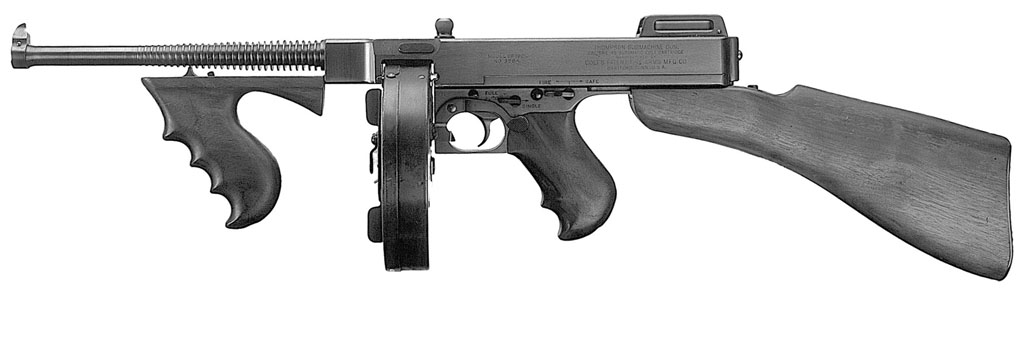
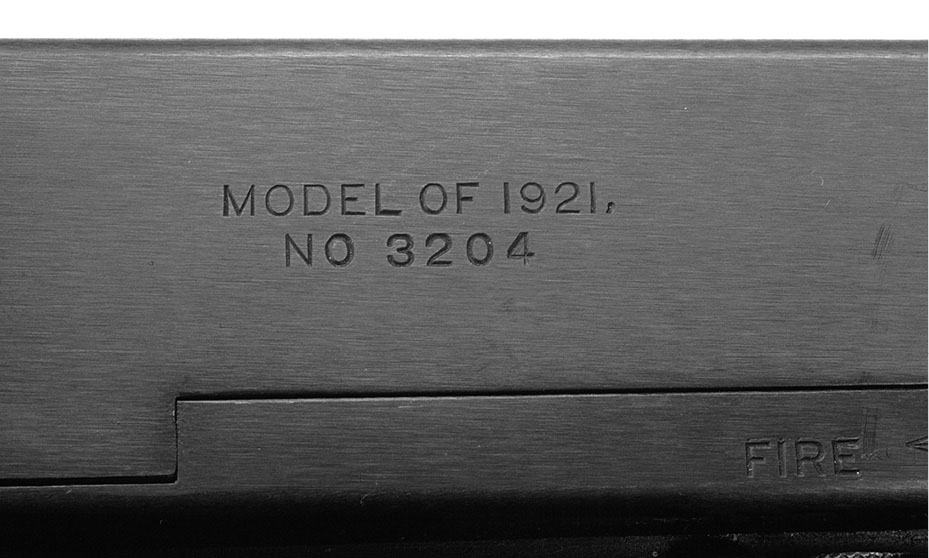
Thompson Model 1921 with close-up of receiver stamping • Paul Goodwin photo
At the outbreak of WWII, the demand for the Thompson gun soared. A brake lining facility in Bridgeport, Conn., was acquired to accommodate the increased demand for production. Three models of Thompsons were born in this WWII era. The first was the Model 1928A1 Thompson. This version was a copy of the Model 1928 Navy Colt Thompson. Most were parkerized with much less detail paid to fine machining. This gun was assembled in two locations: Utica, N.Y., and Bridgeport, Conn. Receivers produced in Utica were marked with an “S” prefix in front of the serial number. Receivers marked with an “AO” prefix were produced in Bridgeport. Receivers were marked on the right side “AUTO ORDNANCE CORPORATION, BRIDGEPORT, CT,” no matter where the receiver was manufactured. The Utica, N.Y., plant concentrated its efforts on manufacturing components while the Bridgeport facility concentrated on assemblies. As production increased, the Model 1928A1 lost many of its “unnecessary” components such as the finned barrel, the costly Lyman sight, and finely checkered selector switches. Approximately 562,000 Thompsons were produced in the Model 1928A1 configuration. All of the weapons were parkerized, and some have finned barrels and some have smooth barrels. Some of these guns were also fitted with Lyman sights, some have a stamped “L” type sight that may or may not have protective ears. As a general rule of thumb, most Model 1928 Commercial guns were fitted with a vertical foregrip while most Model 1928A1 guns were fitted with a horizontal forearm, and all had removable butt stocks. Used by Allied forces during WWII. Used both 20- or 30-round box magazines and 50- or 100-round drum magazines.
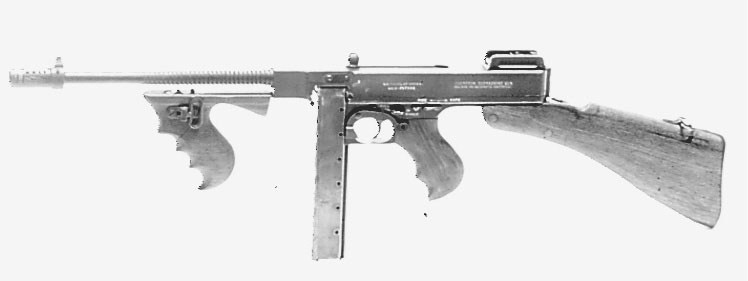
Thompson Model 1928 Commercial
Pre-1968
Exc. |
V.G. |
Fair |
35000 |
25000 |
20000 |
Thompson Model 1928A1 Military
Pre-1968
Exc. |
V.G. |
Fair |
28000 |
22000 |
18500 |
Thompson M1/M1A1
In April 1942, the M1 Thompson was introduced. It was a simplified version of the Model 1928 with a smooth barrel, stamped rear “L” sight, and a fixed rear stock. The expensive Model 1928-type bolt assembly was modified to simplified machining procedures. The result was a repositioned cocking knob on the right side of the receiver. Some 285,000 M1s were produced before being replaced by an improved version, the “M1A1,” in April 1942. This version of the Thompson has a fixed firing pin machined into the bolt face, and had protective ears added to the rear sight assembly. All M1 Thompsons were fitted with a horizontal forearm and fixed butt stock. Approximately 540,000 M1A1 Thompsons were produced before the end of WWII. All M1 and M1A1 Thompsons used stick or box magazines only.

Courtesy Richard M. Kumor, Sr.
NOTE: Many of these weapons were reworked by a military arsenal during the war and may have been refinished; however, it does not significantly reduce the value of the gun. In addition to the rework, many of the serial numbered lower assemblies were not assembled with the correct serial numbered receiver. Although this may disturb some collectors, it should not significantly devalue the weapon. A very small percentage of these weapons were marked “US PROPERTY” behind the rear sight and this increases the value by as much as $1,000.
Pre-1968
Exc. |
V.G. |
Fair |
25000 |
22500 |
18500 |
Third Generation Thompsons
In 1975, the Auto Ordnance Corp., West Hurley, New York, began production of the new Model 1928 Thompson. It was an attempt to produce a version of the Thompson for the civilian collector as well as a limited number of law enforcement sales. The early weapons were manufactured from surplus WWII components and were quite acceptable in quality. As time wore on, however, many of the components were of new manufacture and lesser quality. Between 1975 and 1986, approximately 3,200 models of the 1928 were produced. Some of these guns were commemorative models. The weapons had finned barrels, flip-up rear leaf sights, removable stocks, and blued finish. In 1985 and 1986, approximately 600 versions of the M1 Thompson were built. These were actually a version of the M1A1 military Thompson with blued finish. With the exception of a short production run for export in 1992, production of these weapons was banned in May 1986 by Federal law. All receivers were marked “AUTO-ORDNANCE WEST HURLEY, NEW YORK” on the right side of the receiver and “THOMPSON SUB-MACHINE GUN, CALIBER .45 M1” on the left side. All serial numbers carried the letter “A” suffix. A very limited number of .22 caliber models were produced in the Model 1928 configuration, but had limited success in the market. Auto-Ordnance is now (2007) owned by Kahr Arms; export production of the Thompson SMG has apparently been discontinued.
Thompson Model 1928—West Hurley
Pre-1986 manufacture
Exc. |
V.G. |
Fair |
20000 |
15000 |
N/A |
Thompson Model M1—West Hurley
Pre-1986 manufacture
Exc. |
V.G. |
Fair |
18000 |
10000 |
N/A |
Thompson Model 1928 .22 caliber—West Hurley
Pre-1986
Exc. |
V.G. |
Fair |
15000 |
10000 |
6000 |
UD (United Defense) M42
Built by Marlin for U.S. military forces beginning in 1942. Designed by Carl Swebilius, founder of High Standard. Well constructed of excellent materials. Chambered for the 9mm Parabellum cartridge. Select fire with rate of fire of 700 rounds per minute. Barrel length was 10.8”. Weight is about 9 lbs. Markings on left side of receiver are “UNITED DEFENSE SUPPLY CORP/ US MODEL 42/MARLIN FA CO NEW HAVEN.” Magazine capacity is 20 rounds. Limited quantities produced with an estimate of about 15,000 produced. It seems that the majority were built to be sold to the Netherlands during WWII but, because of the war, they could not be delivered, so most were shipped to the American OSS for use in Europe and the Far East. These guns saw a lot of action during the war.
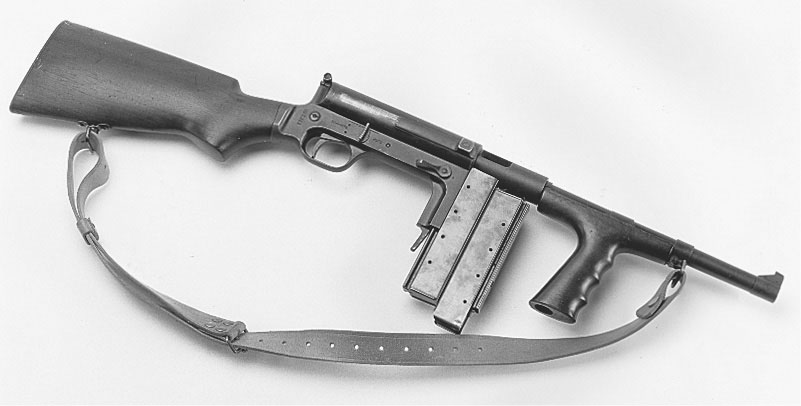
Private NFA collection, Gary Gelson photo
Pre-1968
Exc. |
V.G. |
Fair |
20000 |
15000 |
12500 |
Pre-1986 conversions
Exc. |
V.G. |
Fair |
12000 |
10000 |
9000 |
US M3
First produced in the U.S. in 1942, this submachine gun was chambered for the .45 ACP or 9mm cartridge (special conversion kit). It is similar in concept to the British Sten gun. It was fitted with an 8” barrel and folding metal stock. The box magazine capacity was 30 rounds. The rate of fire was 400 rounds per minute. Weight of the M3 was about 8 lbs. It was produced until 1944. Marked “GUIDE LAMP DIV OF GENERAL MOTORS/US MODEL M3” on top of the receiver. Approximately 600,000 M3s were produced. Built by the Guide Lamp Division of General Motors.
NOTE: A suppressed version of this gun was built for the OSS in World War II, and used for covert operations in Vietnam as well. Too rare to price.

US M3 • Courtesy Richard M. Kumor Sr.
Pre-1968
Exc. |
V.G. |
Fair |
22500 |
19000 |
15000 |
Pre-1986 manufacture with new receiver
Exc. |
V.G. |
Fair |
15000 |
12000 |
N/A |
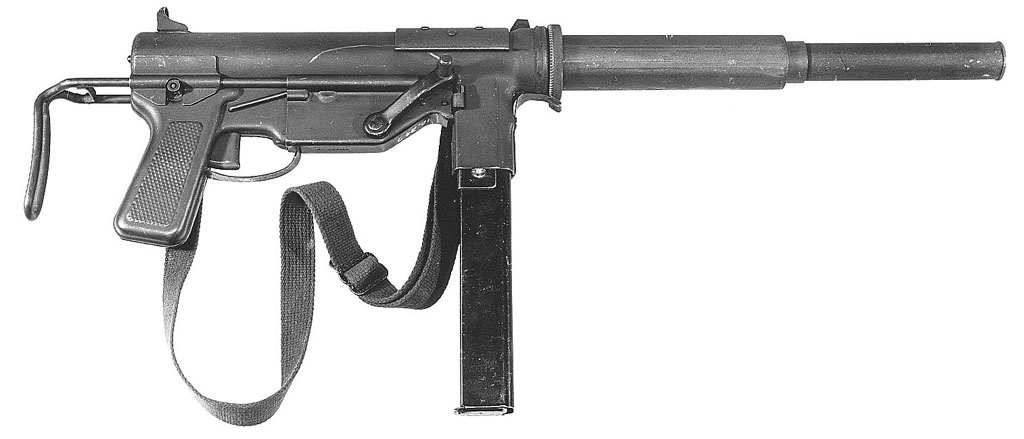
U.S. M3 with silencer • Courtesy Chuck Karwan
US M3A1
Similar to the M3 but with significant changes and improvements. This model has a larger ejection port, the retracting handle has been eliminated, a finger hole is used for cocking, disassembly grooves were added, a stronger cover spring was installed, a larger oil can is in the grip, a stock plate and magazine filler were added to the stock, and a guard was added for the magazine catch. First produced in 1944. Approximately 50,000 M3A1s were built. This version was built by Guide Lamp and Ithaca.

US M3A1 • Courtesy private NFA collection
Pre-1968
Exc. |
V.G. |
Fair |
22500 |
17500 |
15000 |
Pre-1986 manufacture with new receiver
Exc. |
V.G. |
Fair |
15000 |
12000 |
N/A |
U.S. Pre-Cartridge Era Rifles
The United States military issued dozens of models of flintlock and percussion long arms through 1867 when the first cartridge loading arms were adopted. There is not nearly enough space in this guide to provide listings of the countless sub variations and experimental models that were produced in this era. We suggest the reader consult Flayderman’s Guide to Antique American Firearms for more complete information on U.S. Military Weapons.
Harpers Ferry, Virginia
Established at Harpers Ferry, Virginia, in 1798 as the new nation’s “Southern Armory,” production finally began in 1800 and continued at the “musket works” until the facilities were seized by Virginia state militia in April 1861. With the signing of a contract in 1819 between the government and J.H. Hall, the latter was permitted to construct a separate facility for the production of his patent breechloading rifles, which continued to be known as the “rifle works” after the discontinuation of Hall production until it, too, was seized by Virginia militia in 1861. The machinery of the former was sent to Richmond to be used in the manufacture of the “Richmond rifle musket” while the rifle machinery was sent to Fayetteville, North Carolina, where it was employed in making “Fayetteville rifles.”
Harpers Ferry U.S. M1816 Muskets (Types I to III)
Overall length 57-3/4 inches; barrel length 42 inches; caliber .69. Markings: on lockplate eagle over “US” forward of cock, “HARPERS/FERRY/(date) on tail. Barrel tang also bears the date, and barrel should show proofmarks on upper left side near breech. The 45605 (type 1) muskets produced at Harpers Ferry from 1817 through 1821 were made with a lower sling swivel that was attached to a separate lug extending from the forward strap of the trigger guard. In 1822, this piece was eliminated and the balance of the production (216,116) officially known as the M1822 musket, incorporated the lower sling swivel directly to the trigger guard bow. Until 1832, these muskets were manufactured with a “browned” barrel to inhibit rusting. The brown barrels of these 107,684 muskets distinguish them as Type II production. The balance of production until 1844 (98,432) were made with bright barrel, distinguishing Type III muskets. Despite the large numbers produced, most were altered to percussion during the 1850s. Most by the “cone-in-barrel” (so called arsenal) method. Many of these were altered again during the American Civil War, usually with a “Patent Breech,” and were then rifled and sighted.


In flintlock
Exc. |
V.G. |
Good |
Fair |
Poor |
— |
3000 |
2000 |
1500 |
500 |
Altered to percussion
Exc. |
V.G. |
Good |
Fair |
Poor |
— |
900 |
500 |
350 |
200 |
NOTE: Add 100 percent for Type III flintlock muskets (Rare).
Harpers Ferry U.S. M1819 Hall Rifle (Types I and II)
Overall length 52-3/4 inches; barrel (bore) length 32-5/8 inches; caliber.52. Markings: on top of receiver, either “J.H. HALL/H.FERRY/(date)/U.S.” or “J.H. HALL.S./(date).” The 2,000 rifles manufactured between 1824 and 1826 (Type I) are distinguished by having their barrel bands retained by band springs on the right side of the stock. The balance of production (17,680), made between 1828 and 1840, have pins driven through the bands and the stock, distinguishing Type II production. Many of these rifles were altered to percussion just before and in the early months of the American Civil War. Those with evidence of having been altered in the South will command a premium.

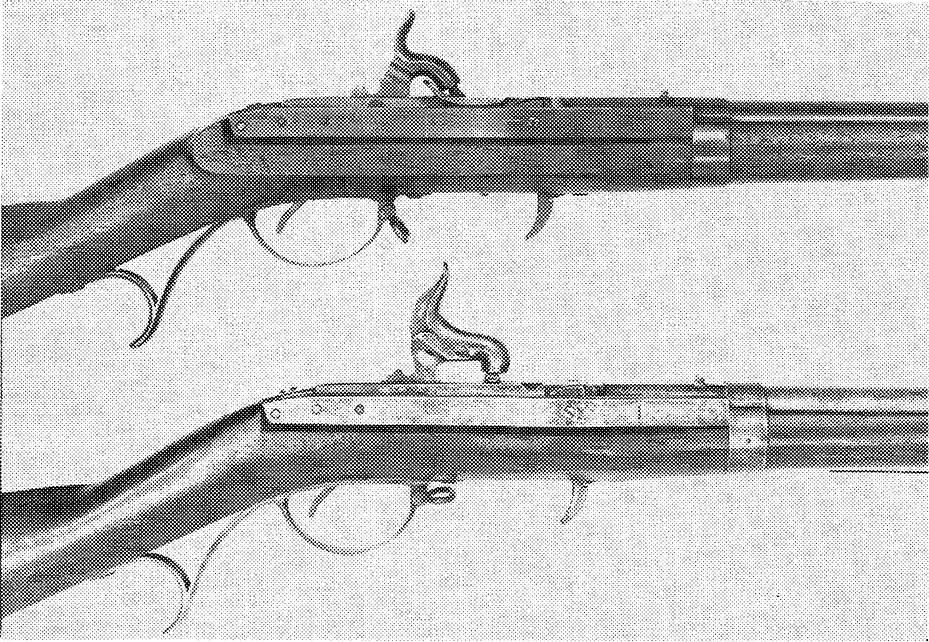
In flintlock
Exc. |
V.G. |
Good |
Fair |
Poor |
— |
3850 |
2200 |
1250 |
500 |
Altered to percussion
Exc. |
V.G. |
Good |
Fair |
Poor |
— |
2550 |
1500 |
750 |
350 |
NOTE: For Type I flintlocks add 250 percent.

Harpers Ferry U.S. M1841 Hall Rifle
Overall length 52-3/4 inches; barrel (bore) length 32-5/8 inches; caliber .52. Markings: on top of receiver, either “J.H. HALL/H.FERRY/US/ (date).” With the general adoption of the percussion system of ignition, the manufacture of Hall’s rifles was changed to conform to the new system, a cone tapped directly into the breechblock substituting for the frizzen and pan, and a hammer replacing the flint cock. The newly made percussion arms also incorporated the newly adopted “fishtail” latch for levering the breechblock. Two-thirds of the 4,213 rifles made were still in storage at the arsenal when it was burned in 1861, enhancing the rarity of the arm.
Exc. |
V.G. |
Good |
Fair |
Poor |
— |
3500 |
2250 |
950 |
500 |
Harpers Ferry U.S. M1836 Hall Carbine (Types I & II)
Overall length 43"; barrel (bore) length 23"; caliber .64. Markings: on top of receiver, “J.H. HALL/U.S./[date].” To furnish the newly raised 2nd Regiment U.S. Dragoons raised in 1836, Harpers Ferry Armory was directed to construct 1,003 Hall carbines, differing in length and caliber over the M1833 model produced by the North for the 1st Regiment, but were not ready when the unit was sent to Florida. Another 1,017 were made during 1839-1840 with the addition of a tool compartment in the buttstock, distinguishing type II production.

Exc. |
V.G. |
Good |
Fair |
Poor |
— |
3500 |
2250 |
950 |
500 |
Harpers Ferry U.S. M1842 Hall Carbine
Overall length 40 inches; barrel (bore) length 21 inches; caliber .52. Markings: on top of receiver, “H. FERRY/U S/1842.” To meet the needs of the U.S. Dragoons for replacement carbines, Harpers Ferry manufactured 1,001 carbines in 1842, differing only from the North M1840 (Type II—“fishtail lever”) carbine by being brass instead of iron mounted.

Exc. |
V.G. |
Good |
Fair |
Poor |
— |
6000 |
4500 |
2000 |
800 |
Harpers Ferry U.S. M1841 Muzzleloading Rifle—The “Mississippi Rifle”
Overall length 49 inches; barrel length 33 inches; caliber .54 (altered to .58 after 1857). Markings: on lockplate, eagle over “US” forward of hammer; “HARPERS/FERRY/(date)” on tail; date also on tang of breechplug; inspector’s initials “AW/P” or “WW/P” and proofmarks (eagle’s head, “V” and “P” on upper left side of barrel). With the discontinuance of production of the Hall patent arms, Hall’s Rifle Works was transformed into the production of the new U.S. rifle adopted in 1841. From 1846 until 1855 a total of 25,296 were manufactured at Harpers Ferry. Approximately 10,000 of these rifles were subsequently adapted for long range firing and to saber bayonets at Harpers Ferry between 1855 and 1861. The adaptations in chronological order included the adoption of the Snell bayonet and Benton long range “screw” sight, the adoption of a saber bayonet lug with guide and the Benton sight, the adoption of the saber bayonet lug with guide and the Burton “ladder” long range sights, the adoption of the U.S. M1855 (Type 1) rifle sights and bayonet lug (first in .54 and then in .58 caliber), and finally the adoption of the U.S. M1855 (Type II) rifle sights and bayonet lug (in .58 caliber). A few thousand were also adapted to the Colt revolving rifle sights and split ring bayonet adaptor in 1861-1862, but that adaptation was not restricted to Harpers Ferry-made rifles.


Exc. |
V.G. |
Good |
Fair |
Poor |
— |
3500 |
1750 |
1200 |
650 |
Harpers Ferry U.S. M1842 Musket
Overall length 57-3/4 inches; barrel length 42 inches; caliber .69. Markings: on lockplate, eagle over “US” forward of hammer; “HARPERS/FERRY/(date)” on tail; date also on tang of breechplug; inspector’s initials and proofmarks on barrel near breech. Harpers Ferry manufactured a total of 106,629 of these smoothbore muskets between 1844 and 1855. Many of these muskets were subsequently rifled and sighted from 1855 to 1858 or simply rifled during the early years of the American Civil War.
Exc. |
V.G. |
Good |
Fair |
Poor |
— |
1850 |
1250 |
900 |
400 |
Harpers Ferry U.S. M1855 Rifle-Musket (Type I & II)
Overall length 56 inches; barrel length 40 inches; caliber .58. Markings: on lockplate, eagle on Maynard primer door; “US/HARPERS FERRY” forward of hammer; date on tail; date also on top of barrel near breech plus proofmarks (eagle’s head, “V,” and “P”). Between 1857 and 1858 Harpers Ferry produced 15,071 of these rifles, but many were still unsighted at the end of the fiscal year. This early production (Type I) is distinguished from the later production (1859-1860) by the absence of the iron “patchbox” on the right side of the buttstock, a long range rear sight, and a brass nosecap. The “patchbox” was added in 1859 together with a short base rear sight with leaves graduated to only 300 and 500 yards. The brass nosecaps were gradually phased out during 1859.
Exc. |
V.G. |
Good |
Fair |
Poor |
— |
3500 |
2250 |
1200 |
700 |
Harpers Ferry U.S. M1855 Rifles (Type I & II)
Overall length 49 inches; barrel length 33 inches; caliber .58. Markings: on lockplate, eagle on Maynard primer door; “U S/HARPERS FERRY” forward of hammer; date on tail; date also on top of barrel near breech plus proofmarks (eagle’s head, “V,” and “P”). Designed as the replacement of the U.S. M1841 rifle, production of the U.S. M1855 rifle began at John Hall’s old “Harpers Ferry Rifle Works” in 1857. The production of 1857 and 1858 (Type I), numbering only 3,645 rifles, were all brass mounted, bore a long range rear sight on the browned barrel, and bore a “patchbox” inletted for a special crosshair figure “8” detachable front sight, though many were still without their rear sights at the end of the fiscal year due to the intervention of the Secretary of War. Most of these were never issued and were subsequently destroyed when the arsenal was set afire in April 1861 to prevent the capture of its arms by Virginia forces. The 3,771 rifles produced between 1858 and April 1861 (Type II) were all iron mounted (though a transitional period continued to utilize the brass nosecaps), eliminated the special front sight (permitting the cavity to be enlarged for greased patches), and employed a short base long range rear sight similar to that of the Type II M 1855 rifle musket.
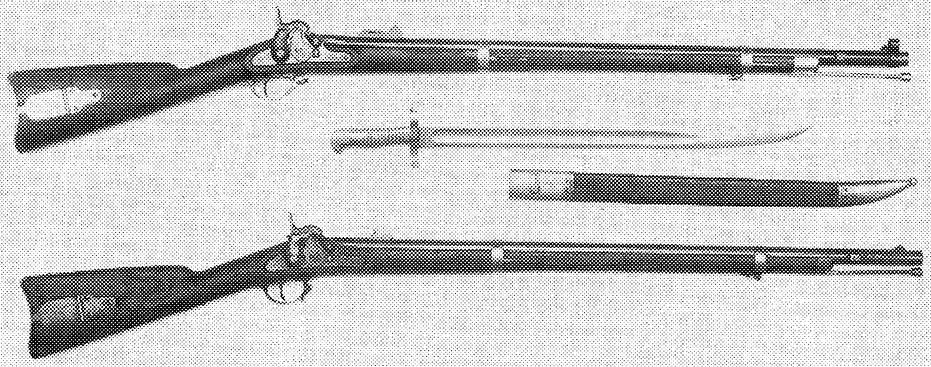

Type I
Exc. |
V.G. |
Good |
Fair |
Poor |
— |
8500 |
4000 |
2750 |
800 |
Type II
Exc. |
V.G. |
Good |
Fair |
Poor |
— |
4500 |
2650 |
1700 |
700 |
Springfield, Massachusetts
This was America’s first federal armory. It began producing military weapons in 1795. The armory has supplied military weapons to the United States throughout its history.
Model 1816 Flintlock Musket (Types I to III)
Overall length 57-3/4 inches; barrel length 42 inches; caliber .69. Markings: on lockplate eagle over “US” forward of cock, “SPRINGFIELD/(date) on tail. Barrel tang also bears the date, and barrel should show proofmarks on upper left side near breech. 325,000 total production. Despite the large numbers produced, most were altered to percussion during the 1850s. Most by the “cone-in-barrel” (so called arsenal) method. Many of these were altered again during the American Civil War, usually with a “Patent Breech,” and were then rifled and sighted.

In flintlock
Exc. |
V.G. |
Good |
Fair |
Poor |
— |
3000 |
2200 |
1500 |
500 |
Altered to percussion
Exc. |
V.G. |
Good |
Fair |
Poor |
— |
900 |
500 |
350 |
200 |
Model 1841 Cadet Musket
This is a single-shot, muzzle-loading rifle chambered for .57 caliber percussion. It has a 40-inch round barrel with a full-length stock held on by three barrel bands. This rifle features no rear sight. It is browned and case-colored, with iron mountings. There is a steel ramrod mounted under the barrel. The lockplate is marked “Springfield” with the date of manufacture and “US” over an eagle motif. There were approximately 450 produced between 1844 and 1845.
Exc. |
V.G. |
Good |
Fair |
Poor |
— |
12500 |
7500 |
3500 |
1500 |
Model 1842 Musket
This is a single-shot muzzleloader chambered for .69 caliber percussion. It has a 42-inch round barrel and a full-length stock held on by three barrel bands. The finish is white with iron mountings and a steel ramrod mounted beneath the barrel. There were a total of approximately 275,000 manufactured between 1844 and 1855 by both the Springfield Armory and the Harper’s Ferry Armory. They are so marked.

Exc. |
V.G. |
Good |
Fair |
Poor |
— |
1900 |
1500 |
900 |
400 |
Model 1851 Percussion Cadet Musket
This single-shot muzzleloader in .57 caliber with 40-inch round barrel is almost identical with the Model 1841 Cadet Musket, the main difference and distinguishing feature is the use of the slightly smaller Model 1847 Musketoon lock. Markings are identical as shown for the Model 1841 Cadet Musket. These weapons were made at the Springfield Armory from 1851 to 1853, with total production of 4,000 guns.

Exc. |
V.G. |
Good |
Fair |
Poor |
— |
1500 |
1000 |
650 |
400 |
Model 1847 Artillery Musketoon
This is a single-shot muzzleloader chambered for .69 caliber percussion. It has a 26-inch round smooth bore barrel. The finish is white, with a full-length walnut stock held on by two barrel bands. The lock is marked “Springfield.” There were approximately 3,350 manufactured between 1848 and 1859.

Exc. |
V.G. |
Good |
Fair |
Poor |
— |
3500 |
2250 |
1500 |
800 |
Model 1847 U.S. Sappers Musketoon
Almost identical to the Model 1847 Artillery except for a lug for sword bayonet mounted on right side of upper barrel band with twin steel guides for bayonet mounted near muzzle. A total of about 830 produced. Be aware of altered Model 1847 Artillery Muskets passed as original Sappers Muskets.
Exc. |
V.G. |
Good |
Fair |
Poor |
— |
3800 |
2750 |
1700 |
900 |
Model 1847 U.S. Cavalry Musketoon
Similar to the Model 1847 Artillery except for a button head ramrod attached with iron swivels under the muzzle. No sling swivels. As many as 6,700 were manufactured.

Exc. |
V.G. |
Good |
Fair |
Poor |
— |
3500 |
2250 |
1500 |
850 |
Model 1855 Rifled Carbine
This is a single-shot muzzleloader chambered for .54 caliber percussion. It has a 22-inch round barrel with a 3/4-length stock held on by one barrel band. The finish is white with iron mountings and a ramrod mounted under the barrel. The lock is marked “Springfield” and dated. There were approximately 1,000 manufactured between 1855 and 1856.
Exc. |
V.G. |
Good |
Fair |
Poor |
— |
15000 |
9500 |
4500 |
2000 |
Model 1855 Rifle Musket
This is a single-shot muzzleloader chambered for .58 caliber percussion. It has a 40-inch round barrel with a full-length stock held on by three barrel bands. It has iron mountings and a ramrod mounted under the barrel. The front sight acts as a bayonet lug. The finish is white with a walnut stock. The lock is marked “U.S. Springfield.” There was also a Harper’s Ferry manufactured version that is so marked. There were approximately 59,000 manufactured between 1857 and 1861.

Exc. |
V.G. |
Good |
Fair |
Poor |
— |
3000 |
1750 |
1100 |
600 |
Model 1858 U.S. Cadet Rifle Musket
Similar to the Model 1855 Rifled Musket but with a 38-inch barrel and shorter stock. The buttstock is 1 inch shorter than the musket and the forearm is 2 inches shorter. About 2,500 were built.
Exc. |
V.G. |
Good |
Fair |
Poor |
— |
3500 |
2250 |
1500 |
900 |
Model 1861 Percussion Rifle Musket
The Model 1861 was the standard musket in use during the Civil War. This .58 caliber single-shot muzzleloader has a 40-inch barrel with three barrel bands and all iron mountings; all metal parts are finished bright (some rear sights are blued) and the stock is walnut. On the lock there is an eagle motif forward of the hammer, US/SPRINGFIELD, beneath the nipple bolster, and the date at the rear section of the lock. About 256,129 of these muskets were made at the Springfield Armory, while almost 750,000 more were made under contract.
NOTE: See entries in Flayderman’s Guide for contract variations.
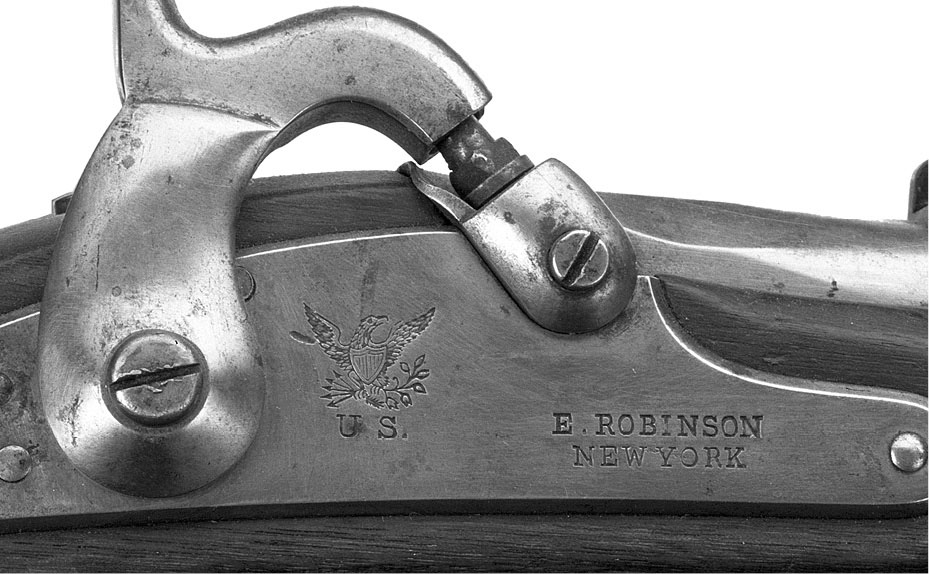
Exc. |
V.G. |
Good |
Fair |
Poor |
4500 |
2250 |
1650 |
850 |
500 |
Model 1863 Rifle Musket, Type I
This is a single-shot muzzleloader chambered for .58 caliber percussion. It has a 40-inch round barrel and a full-length stock held on by three barrel bands. The finish is white with iron mountings, and the lock is marked “U.S. Springfield” and dated 1863. There were approximately 275,000 manufactured in 1863.

Exc. |
V.G. |
Good |
Fair |
Poor |
4500 |
2250 |
1650 |
900 |
500 |
Model 1863 Rifle Musket, Type II, aka Model 1864
This was the last U.S. martial regulation arm of muzzleloading design, and it was widely used during the latter part of the Civil War. Produced at the Springfield Armory between 1864 and 1865, with total production of 25,540 pieces. This weapon is identical to the Type I with the exception of the dating of the lock, which is either 1864 or 1865, a single leaf rear sight, and solid barrel bands secured by flat springs mounted in the stock. The ramrod was either the tulip head type, or the new knurled and slotted design.
Exc. |
V.G. |
Good |
Fair |
Poor |
4500 |
2250 |
1650 |
1000 |
600 |
Providence, Rhode Island
These rifles were made by the Providence Tool Company from 1866 to 1871. Total production for all models was approximately 112,000. These rifles were produced in a wide variety of calibers and used by military forces in Canada, Spain, Switzerland, and others. They were also issued to three state militias: Connecticut, Massachusetts, and South Carolina.
NOTE: U.S. and Canadian marked will bring a premium over foreign marked rifles of about 20 percent.
Rifle
This is a lever-action, top-loading rifle with side hammer. Full stocked with two barrel bands. The front sight also serves as a bayonet fitting. Weight is about 10 lbs. The .45-70 caliber is the most sought-after chambering. Also chambered for the .50-60 Peabody Musket rimfire. In general, European calibers denote foreign military contracts.
NOTE: Canada acquired 3,000 rifles in .50-60 caliber in 1865. Switzerland acquired 15,000 rifles in .41 Swiss rimfire in 1867. Romania acquired 25,000 rifles in .45 Romanian centerfire. France acquired 39,000 rifles during the Franco-Prussian War. Some rifles were chambered for the .43 Spanish centerfire cartridge and some were chambered for the .50-70 cartridge.
Exc. |
V.G. |
Good |
Fair |
2800 |
2000 |
1150 |
700 |
Carbine
This version has the same action but is half stocked with a single barrel band. Chambered for the .45 Peabody rimfire cartridge. Fitted with a 20” barrel. Weight is about 8.5 lbs.

Peabody Carbine • Courtesy Rock Island Auction Company

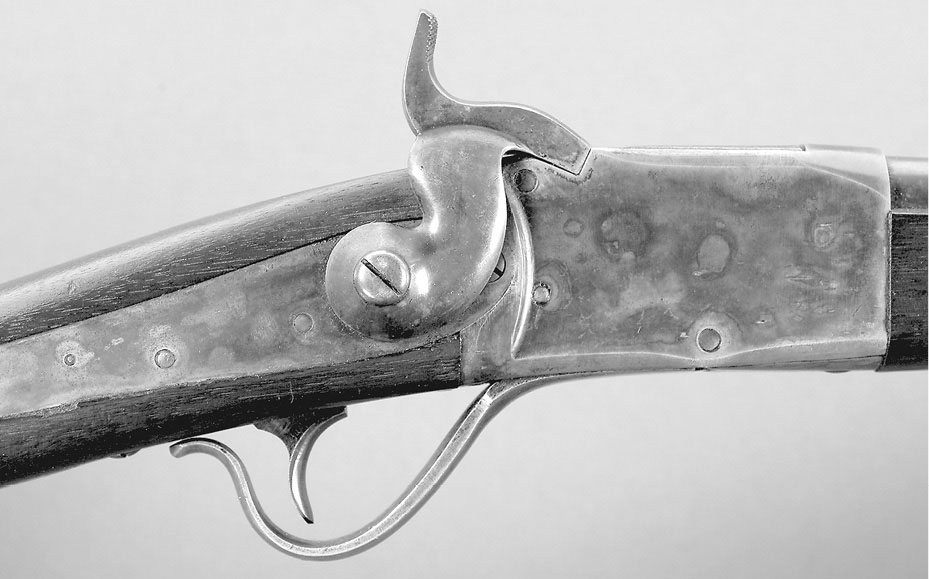
Exc. |
V.G. |
Good |
Fair |
3000 |
2750 |
1500 |
750 |
Model 1874 or 1879 Peabody-Martini Rifle
See Turkey, Rifle, Peabody-Martini or Romania, Rifle, Peabody-Martini.
Boston, Massachusetts
Spencer Model 1860 Carbine
This was one of the most popular firearms used by Union forces during the Civil War. It is chambered for a metallic rimfire cartridge known as the “No. 56.” It is actually a .52 caliber and was made with a copper case. The barrel is 22” in length. The finish is blued, with a carbine-length walnut stock held on by one barrel band. There is a sling swivel at the butt. There were approximately 45,733 manufactured between 1863 and 1865. Cartouche marked.

Courtesy Butterfield & Butterfield, San Francisco, California
Exc. |
V.G. |
Good |
Fair |
— |
— |
4750 |
2000 |
Military Rifle–Navy Model
This model is similar to the carbine, with a 30” round barrel and a full-length walnut stock held on by three barrel bands. It features an iron forend tip and sling swivels. The Civil War production consisted of two models. A Navy model was manufactured between 1862 and 1864 (there were approximately 803 of these so marked).
Exc. |
V.G. |
Good |
Fair |
— |
— |
5000 |
2250 |
Military Rifle–Army Model
There were approximately 11,471 produced for the army during the Civil War. They are similar to the navy model except that the front sight doubles as a bayonet lug. They were manufactured in 1863 and 1864. There were also, according to Marcot, about 200 built for the navy. Cartouche marked, “MMJ” or “DAP” or both.

Courtesy Milwaukee Public Museum, Milwaukee, Wisconsin
Exc. |
V.G. |
Good |
Fair |
7500 |
6000 |
4000 |
2500 |
Springfield Armory Post-War Alteration
After the conclusion of the Civil War, approximately 11,000 carbines were refurbished and rechambered for .50 caliber rimfire. The barrels were sleeved, and a device known as the “Stabler cut-off” was added to convert the arm to single-shot function. Often they were refinished and restocked. The inspector’s marks “ESA” will be found in an oval cartouche on the left side of the stock. These alterations took place in 1867 and 1868.
Exc. |
V.G. |
Good |
Fair |
— |
— |
3750 |
1500 |
Burnside Model 1865 Spencer Carbine Contract
This model was manufactured by the Burnside Rifle Company in 1865. They are similar to the Civil War-type carbine and are marked “By Burnside Rifle Co./Model 1865”. Cartouche marked “HEV and GC” or “LH and GC”.There were approximately 30,502 manufactured for the U.S. Army, and 19,000 of these had the Stabler cut-off device.


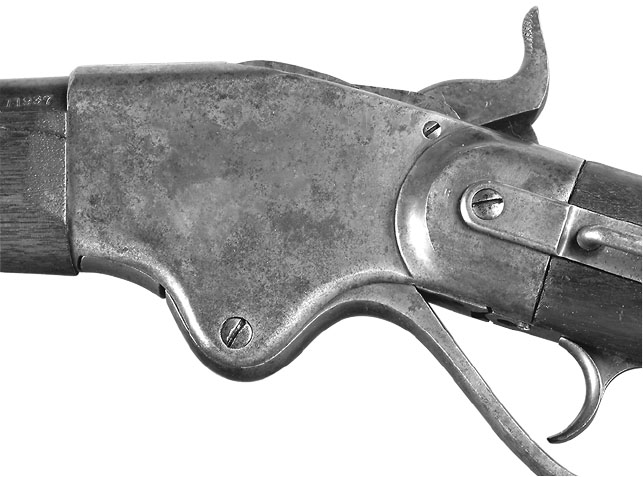
Springfield Armory Post-War Alteration • Courtesy Rock Island Auction Company
NOTE: There were a number of other variations in the Spencer line. This is a complex model with many subtle variations. The best place to begin is with Roy Marcot’s book, Spencer Repeating Firearms, 1983.
Exc. |
V.G. |
Good |
Fair |
— |
— |
3750 |
1500 |
Metallic Cartridge Conversions (1867)
In 1867 approximately 32,000 Model 1859, 1863 and 1865 Sharps were altered to .52-70 rimfire and centerfire caliber. These conversions are cartouche marked in the middle of the left side of the butt stock.
Carbines (.52-70 CF—27,000 converted)
Exc. |
V.G. |
Good |
Fair |
— |
— |
3500 |
2000 |
Rifles (.50-70 centerfire—1,086 converted)
Exc. |
V.G. |
Good |
Fair |
— |
— |
4500 |
2500 |
Model 1869
A .40-50 to .50-70 caliber model produced in a military form with 26”, 28”, or 30” barrels; as a carbine with 21” or 24” barrels and in a sporting version with various barrel lengths and a forend stock fitted with a pewter tip. Approximately 650 were made.
Carbine
.50-70, saddle ring on frame.
Exc. |
V.G. |
Good |
Fair |
— |
— |
4750 |
2000 |
Military Rifle
.50-70, 30” barrel with three barrel bands.
Exc. |
V.G. |
Good |
Fair |
— |
— |
5500 |
2250 |
Model 1870 Springfield Altered
Chambered for .50-70 caliber and fitted with a 35.5” barrel with two barrel bands, walnut stock, case hardened lock and breechlock. Buttplate stamped “US”. Also built for Army trials with 22” barrel converted to centerfire.

Courtesy Butterfield & Butterfield
First Type
Most common, straight breech.


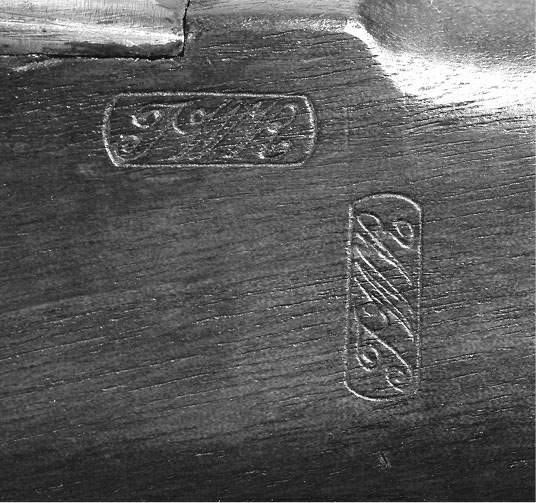

Sharps conversion rifle with cartouches • Courtesy Rock Island Auction Company
Exc. |
V.G. |
Good |
Fair |
— |
— |
4000 |
1750 |
Second Type
Model 1874 action, serial #1 to 300.
Exc. |
V.G. |
Good |
Fair |
— |
— |
6750 |
3000 |
Carbine
22” barrel converted to centerfire.
Exc. |
V.G. |
Good |
Fair |
— |
— |
8250 |
5000 |
Denver, CO & Jackson, WY
NOTE: Thanks to Jim Supica for his research into the Pedersen rifle and carbine that appeared for sale in his Old Town Station Dispatch.
John D. Pedersen was the inventor and designer of the Pedersen device that consisted of a conversion unit to be installed in a modified Springfield .30-06 bolt action rifle. This device allowed the rifle to function as a semi-automatic. At the end of World War I the idea was discarded. During the 1920s, Pedersen and John Garand began working on a new semi-automatic military rifle for U.S. forces. Pedersen’s design was chambered for the .276 caliber and his rifle eventually lost out to Garand’s rifle, the M1. The Pedersen rifles and carbines appear to be part of a test group for military trials. Total number built is unknown.
NOTE: Most Springfield-manufactured Pedersen rifles are so rare as not to be available to the collector. Therefore, only those rifles made by Vickers are listed.

Pedersen rifle at top, carbine at bottom • Courtesy Jim Supica, Old Town Station


Pedersen Carbine • Courtesy West Point Museum, Paul Goodwin photo
Pedersen Rifle
Chambered for .276 Pedersen cartridge. Marked “PEDERSEN SELF LOADER PA/VICKERS-ARMSTRONG LTD.” on the left side of the receiver. In oval over chamber marked “C/2.” Rare.
Exc. |
V.G. |
Good |
Fair |
17500 |
9500 |
7500 |
— |
Pedersen Carbine
Same caliber and markings as rifle, but with 23” barrel. Rare.
Exc. |
V.G. |
Good |
Fair |
19000 |
10000 |
— |
— |
This was America’s first federal armory. It began producing military weapons in 1795 with the Springfield Model 1795 musket. The armory has supplied famous and well-known military weapons to the United States military forces throughout its history. The armory was phased out in 1968. The buildings and its collections are now part of the National Park Service.
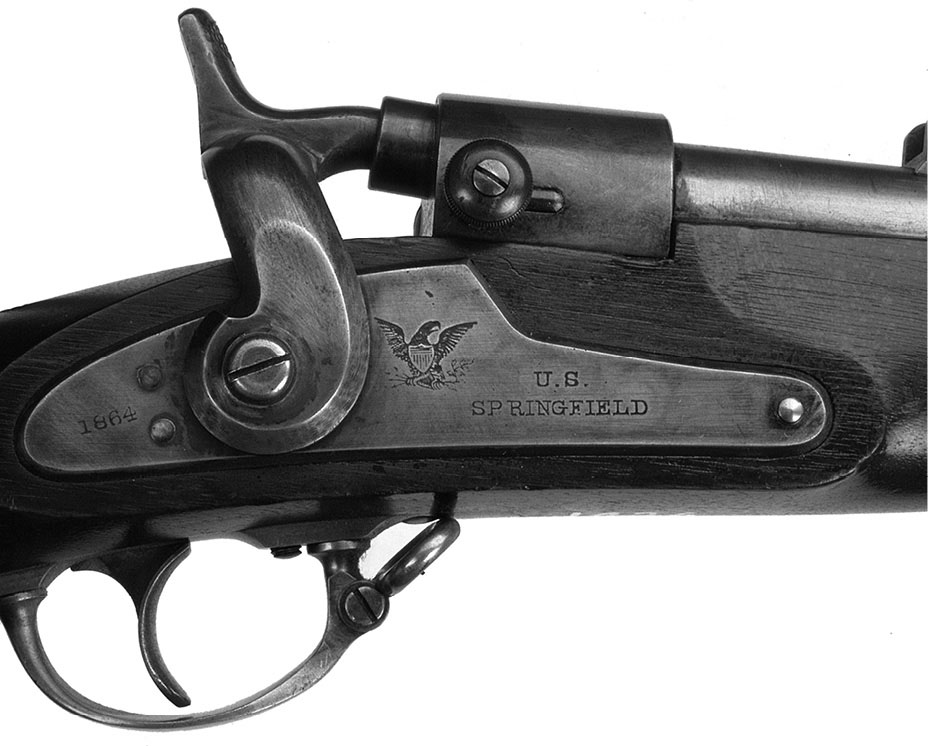

Joslyn Breechloading Rifle • Courtesy West Point Museum, Paul Goodwin photo
Bibliographical Note: For further information, technical data, and photos, see the following: Robert W.D. Ball, Springfield Armory Shoulder Weapons, 1795-1968, Antique Trader Books, 1997. Blake Stevens, U.S. Rifle M14 From John Garand to the M21, Collector Grade Publications. William S. Brophy, The Springfield 1903 Rifles, Stackpole Books, 1985. Bruce Canfield, A Collector’s Guide to the ’03 Springfield, Andrew Mowbray Publishers, 1991.
Joslyn Breech-Loading Rifle
Until recently, this rifle was considered a post-Civil War breechloading conversion of a muzzleloading musket, but information developed since the 1970s indicates that this was the first true breechloading cartridge rifle to be made in quantity by a national armory, circa 1864. Actions were supplied to the Springfield Armory by the Joslyn Firearms Co. where they were assembled to newly made rifles designed for the action. Chambered for the .50-60-450 Joslyn rimfire cartridge, with a 35.5” barrel with three barrel bands, the uniquely shaped lock with eagle ahead of the hammer, “U.S./Springfield” on the front of the lock, with “1864” at the rear. Walnut stock specially made for the barreled action and lock. Converted to 50-70 centerfire will command approximately $100 more.
Exc. |
V.G. |
Good |
Fair |
— |
2500 |
1200 |
700 |
Model 1865 U.S. Breech-Loading Rifle, Allin Conversion, aka First Model Allin
Designed in .58 caliber rimfire, with a 40” barrel with three flat barrel bands. The breechlock is released by a thumb latch on the right side, pivoted upward, with the firing pin contained within the breechblock. 5,000 Model 1861 percussion muskets were altered using this method at the Springfield Armory circa 1865. The breechblock is unmarked, while the lock is marked with the eagle ahead of the hammer, as well as “U.S./Springfield,” with all specimens dated 1865 at the rear.

Exc. |
V.G. |
Good |
Fair |
— |
5000 |
3000 |
1500 |
Model 1866 U.S. Breech-Loading Rifle, Allin Conversion, aka Second Model Allin
Produced in .50 caliber centerfire, with a 40” barrel with a .50 caliber liner tube inserted and brazed, walnut stock with three barrel bands with band springs. Differences between the First and Second Model Allin include a lengthened bolt, a firing pin spring, and a stronger internal extraction system. The breechblock is marked with “1866” over an eagle, while the lock bears standard Springfield markings with either an 1863 or 1864 date. A total of 25,000 Model 1863 percussion muskets were thus altered at the Springfield Armory around 1866.


Model 1866 Breechloading rifle with lock • Paul Goodwin photo
Exc. |
V.G. |
Good |
Fair |
— |
4000 |
2200 |
800 |
Model 1867 U.S. Breech-Loading Cadet Rifle
This model is a .50 caliber centerfire, 33” barrel, two band, scaled down version of the Model 1866 Second Model Allin “trapdoor.” No sling swivels; a narrow triggerguard. The breechblock has a blackened finish, with deeply arched cut-outs on both sides of the underside, leaving a narrow flat ridge in the center. The breechblock is marked 1866/eaglehead. The lock plate was made especially for this rifle and is noticeably thinner. The plate is marked with the usual eagle and “US/ Springfield,” with the date “1866” behind the hammer. About 424 rifles were produced at the Springfield Armory between 1876 and 1868.
Exc. |
V.G. |
Good |
Fair |
— |
10000 |
7500 |
3000 |
Model 1868 Rifle
This is a single shot Trapdoor rifle chambered for the .50 caliber centerfire cartridge. It features a breechblock that pivots forward when a thumblatch at its rear is depressed. It has a 32.5” barrel and a full-length stock held on by two barrel bands. It has iron mountings and a cleaning rod mounted under the barrel. It features an oil-finished walnut stock. The lock is marked “US Springfield.” It is dated either 1863 or 1864. The breechblock features either the date 1869 or 1870. There were approximately 51,000 manufactured between 1868 and 1872.

Courtesy Little John’s Auction Service, Inc., Paul Goodwin photo
Exc. |
V.G. |
Good |
Fair |
— |
2500 |
1250 |
500 |
Model 1869 Cadet Rifle
This is a single-shot trapdoor rifle chambered for .50 caliber centerfire. It is similar to the Model 1868 with a 29.5” barrel. There were approximately 3,500 manufactured between 1869 and 1876.

Courtesy Little John’s Auction Service, Inc., Paul Goodwin photo
Exc. |
V.G. |
Good |
Fair |
— |
3250 |
1500 |
500 |
Model 1870
There are two versions of this Trapdoor breechloader—a rifle with a 32.5” barrel and a carbine that features a 22” barrel and a half-stock held on by one barrel band. They are both chambered for .50 caliber centerfire and feature the standard Springfield lock markings and a breechblock marked “1870” or “Model 1870.” There were a total of 11,500 manufactured between 1870 and 1873. Only 340 are carbines; they are extremely rare.
Rifle

Courtesy Milwaukee Public Museum, Milwaukee, Wisconsin
Exc. |
V.G. |
Good |
Fair |
— |
3750 |
1750 |
800 |
Carbine
Very rare.

Exc. |
V.G. |
Good |
Fair |
— |
16500 |
9500 |
3500 |
Model 1871 Rolling Block U.S. Army Rifle
This model is a .50 caliber centerfire, 36” barrel, with two barrel bands, and rolling block action. Sights, sling-swivels, and most other details as for the Model 1870 Remington U.S. Navy rifle. Case-hardened frame, bright finished iron mountings. Two piece walnut stock. Known as the “locking action” as the hammer went to half cock when the breechblock was closed. No serial numbers. Left side of frame marked “Model 1871.” Right side marked with eagle over “U.S./Springfield/1872.” On the tang, marked “REMINGTON’S PATENT. PAT.MAY 3D, NOV. 15TH, 1864, APRIL 17TH, 1868.” About 10,000 rifles were produced between 1871 and 1872 under a royalty agreement with Remington Arms Co.

Exc. |
V.G. |
Good |
Fair |
7000 |
4500 |
2000 |
750 |
Model 1871 Ward-Burton U.S. Rifle
A .50 caliber centerfire, 32.63” barrel secured by two barrel bands. This is an early bolt action, single shot rifle, with the cartridge loaded directly into the open action, with cocking on the closing of the bolt. Walnut stock, sling swivels on the forward barrel band and the front of the triggerguard. Not serially numbered. The top of the bolt marked, “WARD BURTON PATENT DEC. 20, 1859-FEB. 21, 1871.” Left side of the action marked with American eagle motif and “US/SPRINGFIELD.” 1,011 rifles (32.625” barrel) and 316 carbines (22” barrel) produced at the Springfield Armory basically as a trial weapon.
Rifle

Courtesy Greg Martin Auctions

Close-up of Ward-Burton action • Courtesy George Hoyem
Exc. |
V.G. |
Good |
Fair |
— |
4500 |
2800 |
1250 |
Carbine
Exc. |
V.G. |
Good |
Fair |
— |
6800 |
3500 |
1250 |
Model 1873
This is a Trapdoor breechloading rifle chambered for the .45-70 cartridge. The rifle version has a 32.5” barrel with a full-length stock held on by two barrel bands. The carbine features a 22” barrel with a half-stock held on by a single barrel band, and the cadet rifle features a 29.5” barrel with a full length stock and two barrel bands. The finish of all three variations is blued and case-colored, with a walnut stock. The lock is marked “US Springfield 1873.” The breechblock is either marked “Model 1873” or “US Model 1873.” There were approximately 73,000 total manufactured between 1873 and 1877.


Springfield Model 1873 Carbine with lock • Paul Goodwin photo
NOTE: Prices listed are for rifles in original configuration.
Rifle


Courtesy Milwaukee Public Museum, Milwaukee, Wisconsin
50,000 manufactured.
Exc. |
V.G. |
Good |
Fair |
2500 |
1800 |
1000 |
500 |
Carbine
20,000 manufactured.
Exc. |
V.G. |
Good |
Fair |
3000 |
2200 |
1500 |
850 |
Cadet Rifle
3,000 manufactured.
Exc. |
V.G. |
Good |
Fair |
2200 |
1750 |
750 |
600 |
Bayonet for Model 1873 Springfield
Socket type. 18” blade. Marked “U.S.” on blade. Steel scabbard. Leather frog has brass U.S. or state militia button. Price range 175 – 60.
Trowel Bayonet for Model 1873 Springfield
Socket type. 10” trowel shaped blade. This was designed to be used as a hand shovel. The bayonet application was an afterthought. Not intended to put on the rifle to use as a shovel as it could bend the barrel. Wood plug in socket is to provide a handle while digging. There have been reproductions made of this model. Price range 1000 – 450.
Model 1875 Officer’s Rifle
This is a high-grade Trapdoor breechloader chambered for the .45-70 cartridge. It has a 26” barrel and a half-stock fastened by one barrel band. It is blued and case-colored, with a scroll engraved lock. It has a checkered walnut pistol grip stock with a pewter forend tip. There is a cleaning rod mounting beneath the barrel. This rifle was not issued but was sold to army officers for personal sporting purposes. There were only 477 manufactured between 1875 and 1885.

Bayonet for Model 1873 Springfield

Trowel Bayonet for Model 1873 Springfield



Model 1875 Officer’s Rifle • Courtesy West Point Museum, Paul Goodwin photo
Exc. |
V.G. |
Good |
Fair |
35000 |
25000 |
10000 |
7000 |
Model 1875 Lee Vertical Action Rifle
A .45-70 centerfire, 32.63” barrel secured by two barrel bands. Martini-style dropping block action, with a unique, centrally mounted hammer with an exceptionally long spur. In order to open the breech, the hammer must be given a sharp blow with the heal of the hand; the insertion of a cartridge will automatically close the breech, while the hammer is cocked by hand. All blued finish. Stacking and sling swivel on upper band, with sling swivel on triggerguard. Serially numbered 1 through 143 on the internal parts only. Upper tang marked, “U.S. PAT. MAR 16, 1875,” no barrel proofmarks; inspector’s initials “ESA” in an oval on the stock. 143 rifles produced in 1875 at the Springfield Armory, basically as a trials weapon.


Model 1875 Lee Vertical Action Rifle with patent stamp on upper tang • Paul Goodwin photo
Exc. |
V.G. |
Good |
Fair |
8500 |
5500 |
2500 |
1500 |
Model 1877
This is a Trapdoor breechloading rifle chambered for the .45-70 cartridge. It was issued as a rifle with a 32” barrel and a full-length stock held on by two barrel bands, a cadet rifle with a 29.5” barrel, and a carbine with a 22” barrel, half-stock, and single barrel band. This version is similar to the Model 1873. In fact, the breechblock retained the Model 1873 marking. The basic differences are that the stock is thicker at the wrist and the breechblock was thickened and lowered. This is basically a mechanically improved version. There were approximately 12,000 manufactured in 1877 and 1878.
Rifle
3,900 manufactured.
Exc. |
V.G. |
Good |
Fair |
2500 |
1800 |
1000 |
550 |
Cadet Rifle
1,000 manufactured.


Model 1877 Cadet Rifle • Paul Goodwin photo
Exc. |
V.G. |
Good |
Fair |
2500 |
1800 |
1000 |
550 |
Carbine
4,500 manufactured.

Courtesy Milwaukee Public Museum, Milwaukee, Wisconsin
Exc. |
V.G. |
Good |
Fair |
5000 |
3500 |
2000 |
1250 |
Model 1879 (Model 1873/1879)
This is essentially a Model 1873 with 1879 improvements. The most noticeable improvement is that the receiver is wider and thicker so that it is no longer flush with the barrel, which results in a two-step junction between barrel and receiver. These guns are found in the 100,000 to 280,000 serial number range.
Exc. |
V.G. |
Good |
Fair |
1800 |
1400 |
750 |
500 |
Model 1880
This version features a sliding combination cleaning rod/bayonet that is fitted in the forearm under the barrel. It retained the 1873 breechblock markings. There were approximately 1,000 manufactured for trial purposes in 1880.

Courtesy Milwaukee Public Museum, Milwaukee, Wisconsin
Exc. |
V.G. |
Good |
Fair |
3000 |
2200 |
1000 |
700 |
Model 1881 Marksman Rifle
This is an extremely high-grade Trapdoor breechloading rifle chambered for the .45-70 cartridge. It has a 28” round barrel and is similar to the Model 1875 Officer’s Rifle in appearance. It features a full-length, high grade, checkered walnut stock held on by one barrel band. It has a horn Schnabel forend tip. The metal parts are engraved, blued, and case-colored. It has a vernier aperture sight as well as a buckhorn rear sight on the barrel and a globe front sight with a spirit level. There were only 11 manufactured to be awarded as prizes at shooting matches.
CAUTION: This is perhaps the supreme rarity among the Trapdoor Springfields, and one should beware of fakes.


Exc. |
V.G. |
Good |
Fair |
— |
75000 |
60000 |
20000 |
Model 1881 Long Range Rifle
This model is a Model 1879 chambered for the .45-80 cartridge. The barrel has six groove rifling. The stock has a shotgun butt with Hotchkiss buttplate. Some of these rifles had uncheckered walnut stock with detachable pistol grip and Sharps peep and globe sights. According to Flayderman, this rifle falls between serial numbers 162000 and 162500. It is estimated that less than 200 were produced between 1897 and 1880.


Model 1881 Long Range Rifle • Courtesy Little John’s Auction Service, Inc., Paul Goodwin photo

Model 1882 U.S. Magazine rifle, Chaffee-Reese • Paul Goodwin photo
Exc. |
V.G. |
Good |
Fair |
— |
27500 |
12500 |
5000 |
Model 1882 U.S. Magazine Rifle, Chaffee-Reese
A .45-70 caliber centerfire, 27.78” barrel secured by two barrel bands. One of the early bolt action repeaters, with the cartridges carried in a tubular feed in the butt. Iron mountings, with a blued finish, walnut stock, stacking swivel and sling swivel on the upper barrel band, and a sling swivel on the front of the triggerguard. Not serially numbered. Left side of breech marked “US SPRINGFIELD, 1884,” the barrel marked “V.P.” with eagle head proof. Unfortunately, most rifles found are lacking the feed mechanism in the butt, which lowers the value approximately 15 percent. 753 rifles were produced at the Springfield Armory in 1884.

Courtesy Rock Island Auction Company
Exc. |
V.G. |
Good |
Fair |
5000 |
3500 |
2500 |
900 |
Model 1884
This is also a breechloading Trapdoor single shot rifle chambered for the .45-70 cartridge. It was issued as a standard rifle with a 32.75” barrel, a cadet rifle with a 29.5” barrel, and a military carbine with a 22” barrel. The finish is blued and case-colored. This model features the improved Buffington rear sight. It features the socket bayonet and a walnut stock. There were approximately 232,000 manufactured between 1885 and 1890.

Courtesy Bob Ball
Rifle
200,000 manufactured.
Exc. |
V.G. |
Good |
Fair |
1500 |
1100 |
800 |
500 |
Cadet Rifle
12,000 manufactured.
Exc. |
V.G. |
Good |
Fair |
2000 |
1400 |
850 |
500 |
Carbine
20,000 manufactured.

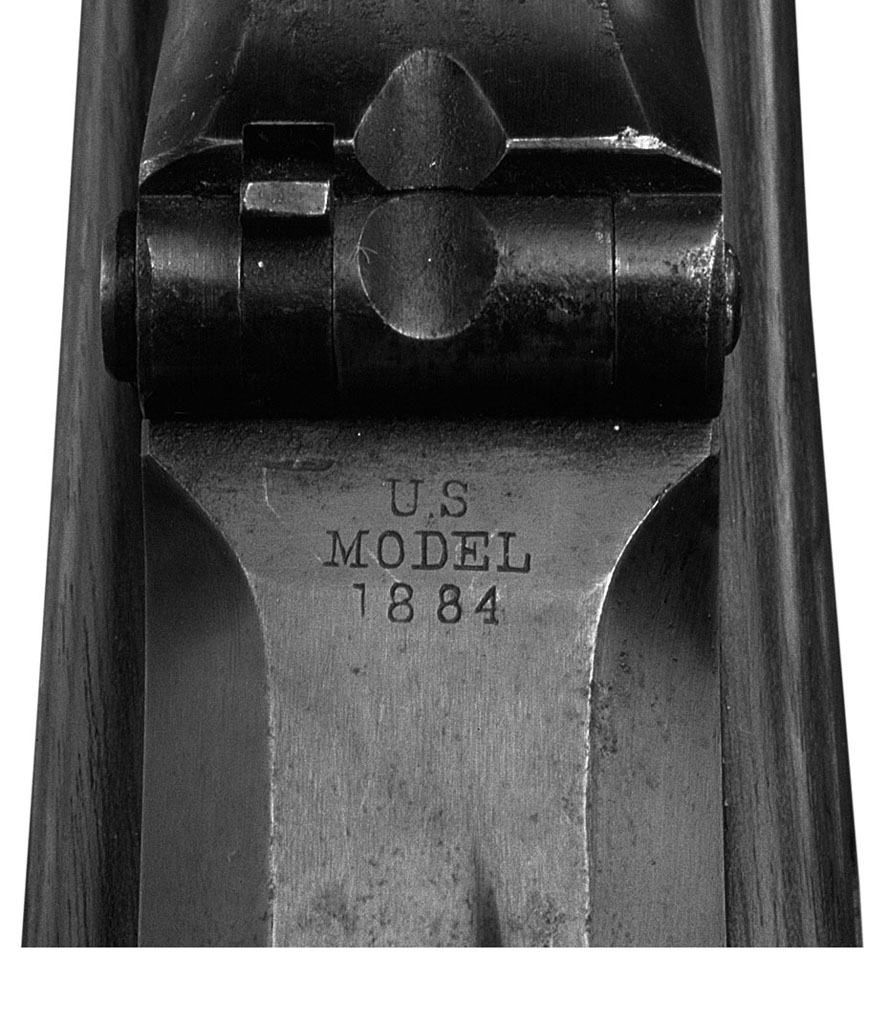
Springfield Model 1884 • Paul Goodwin photo
Exc. |
V.G. |
Good |
Fair |
3000 |
2500 |
1750 |
800 |
Model 1886 Experimental “Trapdoor” Carbine, aka Experimental Model 1882 third/fourth type
Apparently both of these designations are misnomers, as the weapon was officially referred to as the “24” Barrel Carbine. Collectors now call it the Model 1886 to conform to the year of manufacture. The most outstanding feature is the almost full length stock with uncapped, tapered forend. The single upper barrel band is fitted with a bent, or wraparound swivel to facilitate insertion in a saddle scabbard. Lower swivel on butt, with a sling ring and bar on the left side. Cleaning rod compartment in the butt. Buffington-type Model 1884 rear sight marked XC on leaf. About 1,000 produced during 1886.
Exc. |
V.G. |
Good |
Fair |
7500 |
6000 |
4500 |
2500 |
Model 1888
This version is similar to its predecessors except that it features a sliding, ramrod-type bayonet that was improved so that it stays securely locked when in its extended position. The breechblock was still marked “Model 1884.” This was the last Springfield Trapdoor rifle produced. There were approximately 65,000 manufactured between 1889 and 1893.


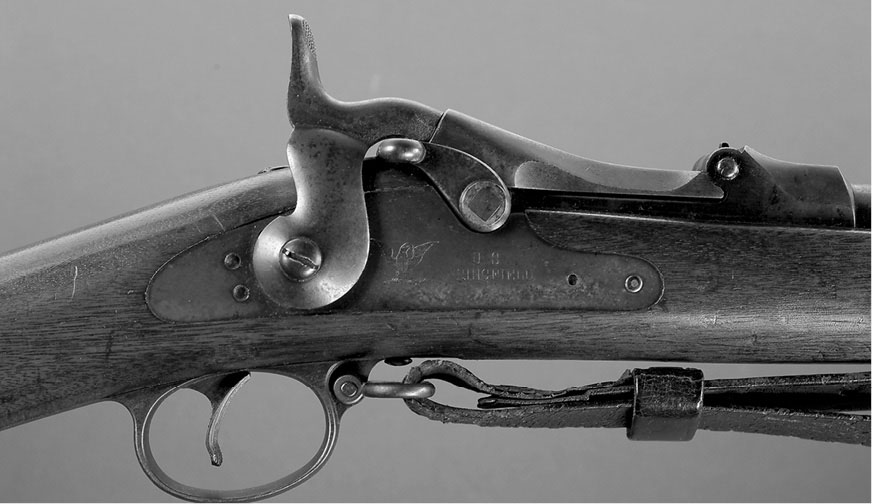
Model 1888 Rifle with bayonet • Courtesy Rock Island Auction Company
Exc. |
V.G. |
Good |
Fair |
1800 |
1250 |
850 |
500 |
Rod Bayonet for Model 1888 Springfield
A 35.5” straight steel rod that tapers to the back end. Stored under the barrel. Not a popular design. They were prone to bending during use. Teddy Roosevelt was vehement in his criticism of this style. Price range 150 – 75.
Trapdoor Fencing Musket
This is a non-gun that was used by the army in teaching bayonet drills. They had no desire to damage serviceable rifles during practice, so they produced this version to fill the bill. There were basically four types produced.
Type I
This version is similar to the Model 1873 rifle without a breech or lock. The finish is rough, and it is unmarked. It was designed to accept a socket bayonet. There were 170 manufactured in 1876 and 1877.
Exc. |
V.G. |
Good |
Fair |
— |
1500 |
750 |
400 |
Type II
This version is basically a Model 1884 with the hammer removed and the front sight blade ground off. It accepted a socket bayonet that was covered with leather and had a pad on its point.
Exc. |
V.G. |
Good |
Fair |
— |
850 |
300 |
250 |
Type III
This version is similar to the Type II except that it is shortened to 43.5” in length. There were approximately 1,500 manufactured between 1905 and 1906.
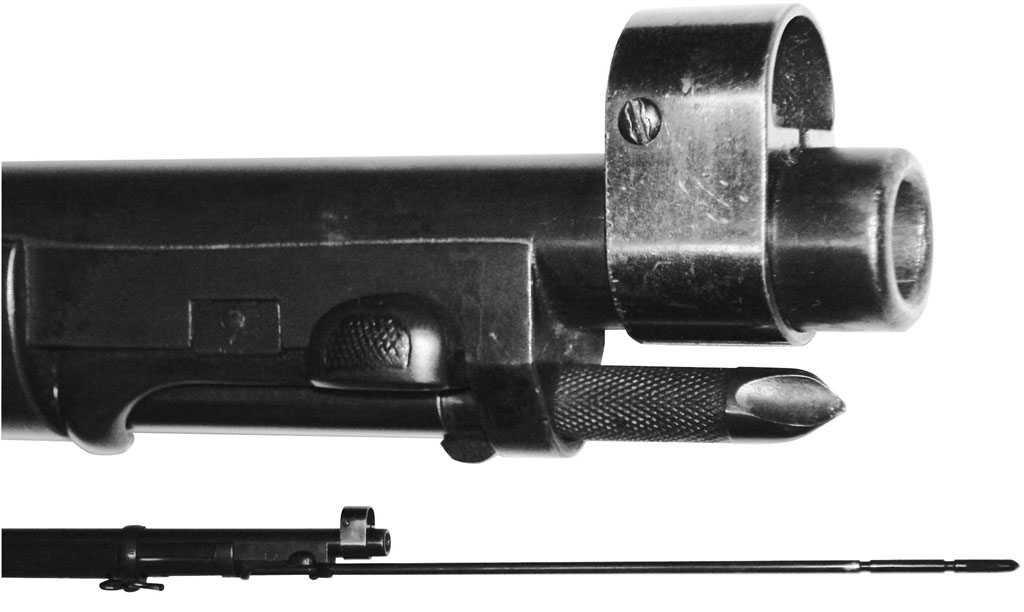
Rod Bayonet for Model 1888 Springfield

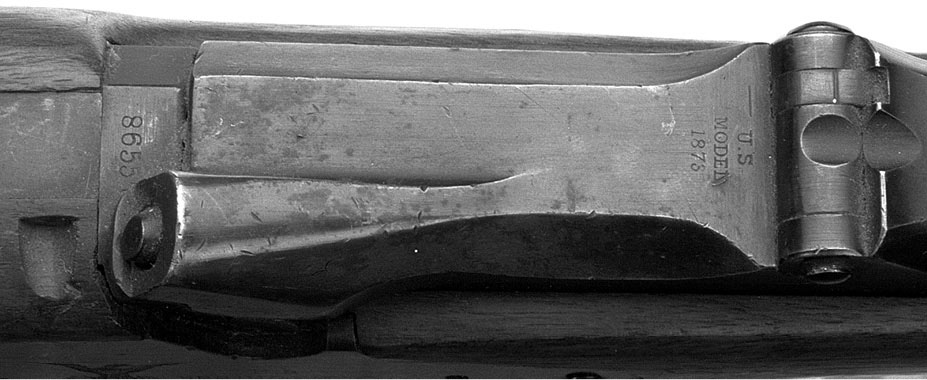
Springfield Fencing Musket, Type I • Paul Goodwin photo
Exc. |
V.G. |
Good |
Fair |
— |
1150 |
450 |
350 |
Type IV
This version is similar to the Type III except that the barrel was filled with lead. There were approximately 11,000 manufactured between 1907 and 1916.
Exc. |
V.G. |
Good |
Fair |
— |
650 |
300 |
250 |
Model 1870 Rolling Block
This is a single shot breechloading rifle with a rolling-block action. It is chambered for .50 caliber centerfire and has a 32.75” barrel. It has a full-length forend held on by two barrel bands. The finish is blued and case-colored, with a cleaning rod mounted under the barrel. The stock and forend are walnut. The frame is marked “USN Springfield 1870.” There is an anchor motif marked on the top of the barrel. It also features government inspector’s marks on the frame. This rifle was manufactured by Springfield Armory under license from Remington Arms Company for the United States Navy. The first 10,000 produced were rejected by our navy and were sent to France and used in the Franco-Prussian War. For that reason, this variation is quite scarce and would bring a 20 percent premium. There was also a group of approximately 100 rifles that were converted to the .22 rimfire cartridge and used for target practice aboard ships. This version is extremely rare. There were approximately 22,000 manufactured in 1870 and 1871.

Courtesy Milwaukee Public Museum, Milwaukee, Wisconsin
Standard Navy Rifle
Exc. |
V.G. |
Good |
Fair |
— |
2800 |
2200 |
1250 |
Rejected Navy Rifle
Exc. |
V.G. |
Good |
Fair |
— |
2000 |
700 |
400 |
.22 Caliber
Exc. |
V.G. |
Good |
Fair |
— |
6000 |
2500 |
900 |
U.S. Krag Jorgensen Rifle
NOTE: This firearm will be found listed in its own section of this text.
These rifles were built by Springfield, Remington, Rock Island Arsenal, and Smith-Corona.
Model 1903
This rifle was a successor to the Krag Jorgensen and was also produced by the Rock Island Arsenal. It was initially chambered for the .30-03 Government cartridge and very shortly changed to the .30-06 cartridge. Its original chambering consisted of a 220-grain, metal jacket soft-point bullet. The German army introduced its spitzer bullet so our government quickly followed suit with a 150-grain, pointed bullet designated the .30-06. This model has a 24” barrel and was built on what was basically a modified Mauser action. It features a 5-round integral box magazine. The finish is blued, with a full length, straight-grip walnut stock with full handguards held on by two barrel bands. The initial version was issued with a rod-type bayonet that was quickly discontinued when President Theodore Roosevelt personally disapproved it. There were approximately 74,000 produced with this rod bayonet; and if in an unaltered condition, these would be worth a great deal more than the standard variation. It is important to note that the early models with serial numbers under 800,000 were not heat treated sufficiently to be safe to fire with modern ammunition. There were a great many produced between 1903 and 1930. The values represented reflect original specimens; WWII alterations would be worth approximately 15 percent less.
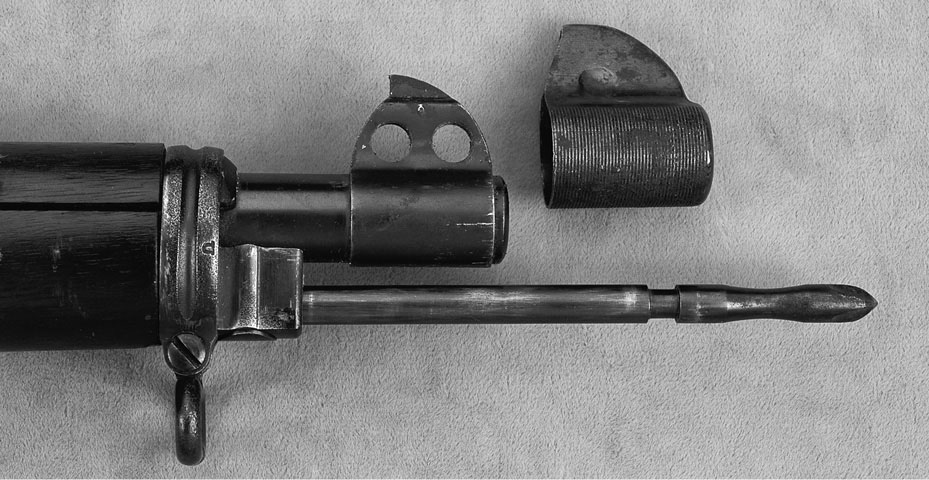

Model 1903 with rod bayonet • Courtesy Little John’s Auction Service, Inc., Paul Goodwin photo

Model 1903 with Model 1905 modifications • Courtesy Little John’s Auction Service, Inc., Paul Goodwin photo
Rod Bayonet Version (Original & Unaltered)
Exc. |
V.G. |
Good |
Fair |
35000 |
20000 |
15000 |
12500 |
NOTE: For rifles restored to Rod Bayonet configuration but in original condition deduct 85 percent.
Rod Bayonet Model 1903 (Altered to Model 1905 in .30-03)
Exc. |
V.G. |
Good |
Fair |
25000 |
15000 |
7500 |
4000 |
Rod Bayonet Model 1903 (Altered to Model 1905
in .30-06)
Exc. |
V.G. |
Good |
Fair |
4750 |
3000 |
1500 |
850 |
Model 1903 Rifle with 1905 Modifications
This model was built in Springfield between 1905 to 1906. Chambered for .30-03 cartridge. Overall barrel length is 24.206” (chamber & bore length is 23.949”). These rifles were newly manufactured and therefore are unaltered. No ramrod bayonet. Model 1905 front and rear sight. Front barrel band is a double strap with bayonet stud and stacking swivel. There is a Model 1905 knife bayonet designed for this model. Rear sight graduated to 2,400 yards with a silver line above and below peep sight aperture. Very Rare.
Original & Unaltered Examples
Exc. |
V.G. |
Good |
Fair |
17500 |
10000 |
5000 |
3000 |
Altered to .30-06
Exc. |
V.G. |
Good |
Fair |
4000 |
2500 |
1200 |
800 |
Model 1903 Rifle
(Altered from Model 1905 in .30-06)
This model was altered to accept a new pointed bullet that required a shortened cartridge case. This required a shorter chamber. The barrel was shortened by setting it deeper into the receiver by .200” therefore making the overall barrel length 24.006” in length (chamber & bore length is 23.749”). This new cartridge was adopted in 1906 and called the “Cartridge, Ball, Caliber 30, Model 0f 1906.” or more commonly known as the .30-06. The rear sight base was also moved forward .200” of an inch and a new graduated rear sight up to 2,700 yards was installed. According to Flayderman the easiest way to determine a Model 1905 altered rifle “... is to remove the upper barrel band to see if a plugged hole appears 1/4” forward of the present upper band screw hole.”

Model 1903 altered from Model 1905 • Courtesy Little John’s Auction Service, Inc., Paul Goodwin photo
Exc. |
V.G. |
Good |
Fair |
3750 |
2750 |
1250 |
700 |
Model 1903 Rifle (1907-1910 in .30-06)
This variation was built both by Springfield and Rock Island. It features a stock with a square corner beside the receiver ring on the right side, a smooth and pointed trigger, smooth buttplate, the bolt handle is not bent back, blued metal. The receiver has a black or mottled finish. Early examples do not have a cross bolt in the stock while rifles built after 1908 have a single cross bolt. About 130,000 were produced in serial number range 269000 to 400000. Original examples are rare as most were arsenal rebuilt with parkerized finish and new features.

Model 1903 dated 1909 • Courtesy Little John’s Auction Service, Paul Goodwin photo
Exc. |
V.G. |
Good |
Fair |
3750 |
2750 |
1250 |
750 |
Model 1903 Rifle (1910-1917 in .30-06)
This variation features a stock with tapered rather than square corner on right side of receiver ring. The trigger is serrated and not pointed. Checkered buttplate, bolt handle is not bent back, and metal is blued. Stock has a single cross bolt. Most were arsenal rebuilt. About 250,000 were manufactured between serial numbers 385000 to 635000. Between 1910 and 1913, these rifles were also built by Rock Island.
NOTE: A small number of these rifles were sold to civilians through the DCM program. They are marked “NRA” on the triggerguard. These examples are worth approximately 20 percent more.

Courtesy Little John’s Auction Service, Inc. • Paul Goodwin photo
Exc. |
V.G. |
Good |
Fair |
3750 |
2750 |
1250 |
700 |
Model 1903 Rifle (1917-1921 in .30-06)
This variation features a parkerized finish with smooth buttplate, many have smooth triggers that have a thick contour. Two cross bolts in stock. This particular variation does not have the attention to detail and finish that peacetime rifles have. Many of these rifles were arsenal rebuilt. About 590,000 of this variation were manufactured between serial numbers 635000 to 1225000.

Model 1905 Bayonet for 1903 Springfield
Exc. |
V.G. |
Good |
Fair |
2500 |
1800 |
1000 |
700 |
NOTE: Rifles built between 1917 and 1918 will bring a 20 percent premium.
Model 1903 Rifle (1921-1929)
This variation features parkerized metal finish with checkered buttplate and serrated triggers. Stock have grasping grooves and straight grips. Many of these rifles were arsenal refinished and reassembled with different combinations of parts. About 80,000 were manufactured between serial numbers 1200000 and 1280000.
Exc. |
V.G. |
Good |
Fair |
2500 |
1500 |
800 |
700 |
Model 1905 Bayonet for 1903 Springfield
Wood grips. Muzzle ring. 16” single edge blade. Polished steel or blued finish. Some refinished for service in WWII have a parkerized finish. Marked with “SA” or “RIA” and production date on ricasso. The early scabbards are wood with leather covering. Later scabbards have a olive drab cloth with leather tip. There are several minor variations to in the scabbards. The value of unaltered 1905 bayonets has risen sharply in recent years. There are reproductions on the market. Price range 500 – 300.
Model 1903 Rifle Stripped for Air Service
Special 29” stock, 5.75 upper handguard specially made for this rifle, solid lower barrel band retained by screw underneath, rear leaf sight shortened and altered to open sight with square notch. 25-round extension magazine used. Some 910 rifles produced during the first half of 1918, with serial numbers ranging between 857000 and 863000; all barrels dated in first half of 1918. A very rare and desirable rifle, with the magazine almost impossible to find. Values shown include magazine.

Model 1903 with Air Service magazine • Courtesy Richard M. Kumor Sr.
Exc. |
V.G. |
Good |
Fair |
20000 |
12500 |
7500 |
3500 |
Model 1903 Mark 1
This version is similar to the original except that it was cut to accept the Pedersen device. This device allows the use of a semi-automatic bolt insert that utilizes pistol cartridges. The rifle has a slot milled into the receiver that acts as an ejection port. The device was not successful and was scrapped. Approximately 102,000 rifles were produced with this millcut between 1918 and 1920.


Paul Goodwin photo
Exc. |
V.G. |
Good |
Fair |
2500 |
2000 |
1500 |
600 |
NOTE: The values given are for the rifle alone—not for the device. Rifle must contain all original Mark I parts. For rifles with the device and magazine add $35,000; for rifles with the device but no magazine add $30,000; for the metal carrying scabbard add $7,500.
Model 1903 Mark 1, Reworked Rifle
Many existing Mark 1’s were rebuilt while in U.S. service. The unique Mk1 internal parts were replaced with standard M1903 parts. Some were rebarreled and refinished in pre-WWII rebuild programs.

Pedersen Device • Paul Goodwin photo
Exc. |
V.G. |
Good |
Fair |
900 |
800 |
700 |
500 |
Model 1903 Sniper Rifle
Selected Model 1903 rifles were fitted with telescopic sights from 1907 to 1919; apparently 25 rifles so equipped in 1906, but the type of scope has not been definitely identified. If proven original to the period, specimens would be worth more than shown in the values guide. 400 rifles were fitted with the Warner-Swasey Model 1906, 6-power telescope sight in 1911, with the sights marked Model 1908, as well as with the full Warner-Swasey markings. Scope numbers do not match the rifle numbers. Rifles fitted with this Model 1908 scope will bring approximately 30 percent more than the values shown. Approximately 5,000 rifles were fitted with the Model 1913 Warner-Swasey telescopic sight up to 1919; similar to the Model 1908, they were only 5.2 power. When originally fitted, the scopes were numbered to the rifles; however, scopes were sold separately from the rifles as surplus and were never numbered. These were later fitted to other weapons and the chance of finding matching numbers greatly decreases. Values shown are for original guns with original, matching telescopes.
The U.S. Marine Corps also had its own versions of the Model 1903 Sniper. Early rifles were fitted with a Winchester A5 5X scope or a Lyman 5A 5X scope. Later examples were fitted with a Unertl 8X scope marked “USMC.” All Marine Corps scopes had target bases.

Courtesy Bob Ball
Exc. |
V.G. |
Good |
Fair |
9500 |
7500 |
4000 |
2500 |
NOTE: A few Model 1903 and 1903A1 rifles will have barrels marked “USMC” and the date. These barrels were installed by the Sedgley Company. Add a premium of about 15 percent for these barrels.
Model 1903 A1
This version is a standard Model 1903 rifle that was fitted with a Type C, semi-pistol grip stock. All other specifications were the same except for a checkered butt and serrated trigger.
Exc. |
V.G. |
Good |
Fair |
1800 |
950 |
750 |
500 |
World War II Model 1903s
For a complete explanation, with photos and technical data see Bruce Canfield’s U.S. Infantry Weapons of World War II.
According to Canfield, the majority of World War II Model 1903 rifles were rebuilt. The extent varied from rifle to rifle. Look for the following alterations:
Model 1903 (Remington, WWII)
Remington began production of the Model 1903 in November 1941. These very early rifles are identical to the Rock Island Model 1903. About 1,273 of these early rifles were produced. The balance of Remington Model 1903 rifles were built using less expensive methods. Tolerances were eased and more stamped parts were employed. These rifles were stamped “Remington Model 1903,” and small parts were stamped “R.” These early Remington rifles will be found in serial number range 3000 to about 3050000.
Exc. |
V.G. |
Good |
Fair |
850 |
700 |
500 |
250 |
NOTE: Very early Remington rifles, the first 1,273, will bring a premium over the later rifles.
Model 1903 (Remington, WWII, Modified)
This version of the Model 1903 was a further attempt to reduce cost and increase production. The right gas escape hole was eliminated, and a number of machining operations were omitted. This version is known as the Model 1903 Modified. These rifles are found in serial number range 3050000 to about 3365000.
Exc. |
V.G. |
Good |
Fair |
850 |
700 |
500 |
300 |
Model 1903 A3
This version was introduced in May of 1942 for use in WWII. It basically consisted of improvements to simplify mass production. It features an aperture sight and various small parts that were fabricated from stampings; this includes the triggerguard, floorplate, and barrel band. The finish is parkerized. Receiver ring is marked “03-A3.” This model was manufactured by Remington and Smith-Corona.

Courtesy Bob Ball
Exc. |
V.G. |
Good |
Fair |
1000 |
850 |
500 |
350 |

Model 1942 Bayonet
WWII-Issue Bayonets for M 1903, 1903-A3 and M-1 Garand
Model 1942
Ribbed black or brown grips. Muzzle ring. 16” single edge blade. Parkerized finish. This bayonet is the same as the U.S. 1905 design. Dated on ricasso 1942 or 43, with the initials of the manufacturer. Made by six contractors: OL-Oneida Ltd., UFH - Union Fork & Hoe, PAL – Pal Blade co., WT – Wilde Tool, AFH – American Fork & Hoe, U.C. – Utica Cutlery Co. Green plastic scabbard with U.S. ordnance bomb marking. Price range 350 – 200.
U.S. M-1
Ribbed black or brown grips. Muzzle ring. 10” single edge blade. Made by the same contractors as the M 1942. Price range 200 – 125.
1905-E1
This is a 1905 or 1942 bayonet with the blade shortened to 10”. The fuller groove will run to the tip. There are two tip types. Price range 200 – 125.

Model 1905-E1 Bayonet
Model 1903 A4
Most of these rifles were marked “A3” and not “A4.” The markings were rotated to the side in order not to be covered by the scope mount. This is a sniper-rifle version of the Model 1903. It is fitted with permanently mounted scope blocks and furnished with a telescopic sight known as the M73B1. This scope was manufactured by Weaver in El Paso, Texas, and was commercially known as the Model 330C. The rifle has no conventional iron sights mounted. This model was built by Remington.


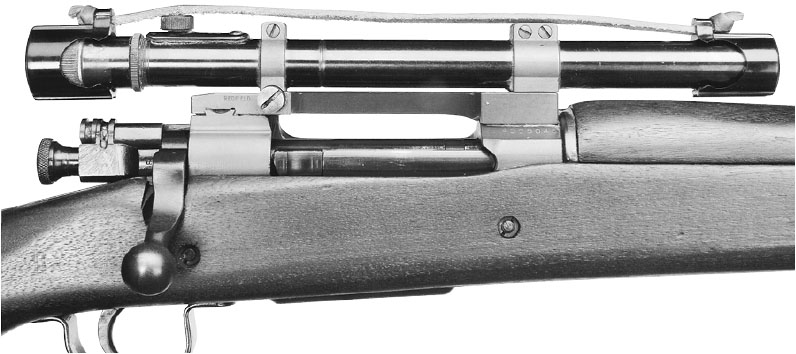

Remington Model 1903/A4 sniper with M73B1 Scope set, semi-pistol grip stock variation, boxed FJA cartouche, and correct factory original bolt handle stock clearance cutout • Courtesy Michael Wamsher, Paul Goodwin photo

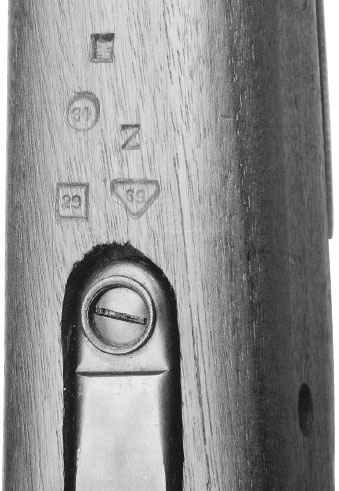

Remington Model 1903/A4 sniper with full pistol grip “C” stock variatio. “FJA” cartouche without box, factory assembly markings and “Circle P” proof markings • Courtesy Michael Wamsher, Paul Goodwin photo



Examples of different scopes and their markings used on the Model 1903/A4 rifle. From right to left: Early Weaver Model 330 scope M73B1 scope, and MB2 scope • Courtesy Michael Wamsher, Paul Goodwin photo



Rifle with WWII rare “French” M73B2 scope. Notice the markings and characteristics of front sight removal • Courtesy Michael Wamsher, Paul Goodwin photo

Model 82 scope circa post-Korean War • Courtesy Richard M. Kumor Sr.
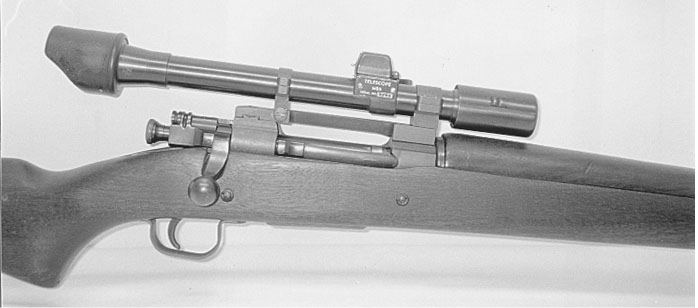
Model 84 scope circa Korea and Vietnam wars • Courtesy Richard M. Kumor Sr.
Exc. |
V.G. |
Good |
Fair |
3000 |
2500 |
1750 |
650 |
NOTE: For those few rifles marked “A4” add a premium of 10 percent.
NOTE: For rifles with M84 scope deduct $250.
Model 1903 NRA National Match
This version was based on a standard 1903 service rifle that was selected for having excellent shooting qualities. The parts were then hand-fit, and a special rifled barrel was added that was checked for tolerance with a star gauge. The muzzle of this barrel was marked with a special star with six or eight rays radiating from it. These NRA rifles were drilled and tapped to accept a Lyman No. 48 rear sight. They are marked with the letters “NRA” and have a flaming bomb proofmark on the triggerguard. There were approximately 18,000 manufactured between 1921 and 1928.
Exc. |
V.G. |
Good |
Fair |
3750 |
2400 |
2000 |
1400 |
NOTE: Prices are for verifiable samples.
Model 1903 A1 National Match
Basically the same as the Model 1903 National Match rifle except for the “C” type, or pistol grip stock, without grasping grooves. Bolts and stocks numbered to the receiver. “P” in a circle proof on the underside of the pistol grip, with either a “DAL” in a rectangular cartouche, or S.A./SPG in a square cartouche. Rifles will be found with either a regular or reversed safety. Approximately 11,000 produced with a serial number range from 1285000 to 1532000.
Exc. |
V.G. |
Good |
Fair |
4500 |
3000 |
2000 |
1200 |
NOTE: Prices are for verifiable samples.
Model 1903 Style National Match Special Rifle
This rifle is identical to the National Match, but with a completely different buttstock configuration identical to the Model 1922 NRA. Large shotgun type steel buttplate; full pistol grip. About 150 rifles produced during 1924.
Exc. |
V.G. |
Good |
Fair |
8500 |
6500 |
5500 |
3500 |
NOTE: Prices are for verifiable samples.

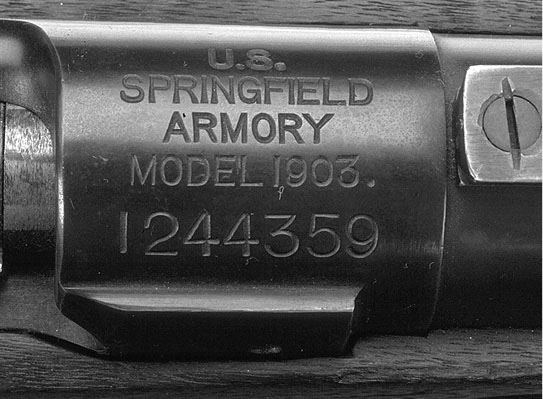
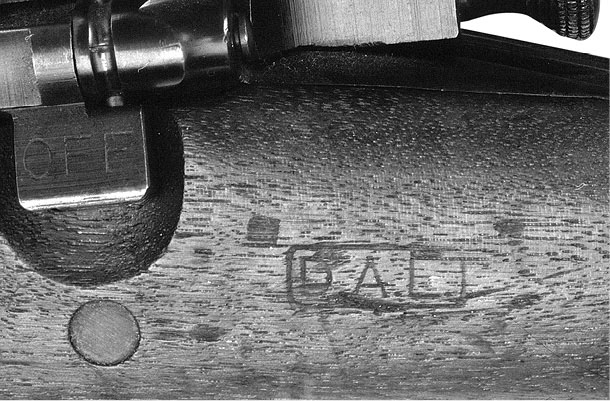

Model 1903 “NB” National Match showing markings • Paul Goodwin photo

Model 1903 National Match Special Rifle • Courtesy Butterfield & Butterfield
Model 1903 Style “NB” National Match Rifle
This rifle produced with the “B” type stock with more drop than standard, suitable only for off-hand shooting; pistol grip configured with a noticeably squared profile. Deep checkered buttplate. Circle “P” proof in underside of pistol grip. About 195 rifles built between 1925 and 1926.
Exc. |
V.G. |
Good |
Fair |
8500 |
6500 |
5500 |
3500 |
NOTE: Prices are for verifiable samples.
Model 1903 NRA Sporter
This version is similar to the National Match rifle but features a half-length, Sporter-type stock with one barrel band. It also features the Lyman No. 48 receiver sight. This version was produced for commercial sales. There were approximately 6,500 manufactured between 1924 and 1933.

Model 1903 NRA Sporter • Courtesy Little John’s Auction Service, Inc., Paul Goodwin photo
Exc. |
V.G. |
Good |
Fair |
3000 |
2000 |
1200 |
700 |
NOTE: Prices are for verifiable samples.
Model 1903 NBA Sporter Rifle
The barrel, action, and sights of this rifle are identical to the Model 1903 NRA Sporter rifle above. However it is fitted with a “B” type stock. Grasping grooves and squared pistol grip profile. Circle “P” proof in the underside of the pistol grip. 589 rifles produced at the Springfield Armory during 1925 and 1926.
Exc. |
V.G. |
Good |
Fair |
8500 |
6500 |
5500 |
2500 |
NOTE: Prices are for verifiable samples.
Model 1903 Heavy Barreled Match Rifles
These rifles were made in a bewildering number of types and variations. Commonly encountered are the style “T” with NRA type stocks. Barrels, which came in three lengths, 26”, 28”, and 30”, measured .860” at the muzzle and 1.250” at the breech. Lyman 48 rear sight; Winchester globe front sight on a modified B.A.R. front band, telescope blocks on the receiver and barrel. Some fitted with adjustable hook type buttplates, set triggers, Garand speed locks, as well as cheekpieces (all commanding premium dollars). INTERNATIONAL MATCH rifles (worth at least double the values shown) have many variant features which were changed annually at the request of the individual shooter. These features include palm rests, double set triggers, beaver-tail forends, checkered pistol grips, Swiss style buttplates, etc. Generally the Winchester 5A telescopic sight was used. These rifles are considered rare. Another variation is the 1922 MATCH SPRINGFIELD RIFLE with NRA type stock with grasping grooves, a 24” barrel with service type front sight mount and small base integral with the barrel, as well as telescopic blocks on the barrel. 566 rifles produced at the Springfield Armory between 1922 and 1930.

Springfield Model 1903 Heavy Barrel Match Rifle • Courtesy Greg Martin Auctions
Exc. |
V.G. |
Good |
Fair |
7000 |
5500 |
4000 |
2500 |
NOTE: Values shown are for the standard heavy barrel match rifle without any special features.
Model 1903 .22 Caliber Gallery Practice Rifle “Hoffer-Thompson”
This practice rifle differed from the standard issue ’03 as follows: the barrel bored and rifled to .22 caliber, the breech chambered for the Hoffer-Thompson cartridge holder, the rear sight graduated to 240 yards, the mainspring shortened, the stocks generally found without cross bolts or the circle “P” on the underside of the pistol grip. Receivers produced after 1901 usually are marked with “.22” on the top of the bridge. About 15,525 rifles were produced at the Springfield Armory between 1907 and 1918.


Model 1903 .22 Caliber Gallery Practice Rifle “HofferThompson” with markings
Exc. |
V.G. |
Good |
Fair |
4000 |
3250 |
2500 |
1500 |
Model 1917
In 1917, when the United States entered WWI, there was a distinct rifle shortage. There were production facilities set up for the British pattern 1914 rifle. This “Enfield” rifle was redesigned to accept the .30-06 cartridge and was pressed into service as the U.S. rifle Model 1917. This rifle appears similar to the British pattern 1914 rifle. In fact, they are so similar that in WWII, when over a million were sold to Britain for use by their Home Guard, it was necessary to paint a 2” stripe around the butt so that the caliber was immediately known. The barrel length is 26”, and it has a 6-round integral box magazine. The finish is matte-blue, with a walnut stock. Towards the end of production parkerized parts were added. The breech is marked “U.S. Model 1917.” This was a robust and heavy-duty rifle, and many are used in the manufacture of large-bore custom rifles to this day. There were approximately 2,200,000 manufactured by Remington, Winchester, and Eddystone between 1917 and 1918. The majority were produced at Eddystone, Pennsylvania.

Model 1917 Rifle (Winchester) • Courtesy Rock Island Auction Company

Remington Model 1917 receiver markings • Courtesy Karl Karash
During World War II all parts were parkerized, and barrels were supplied by the Johnson Automatics Company as a result of the rebuild.
Exc. |
V.G. |
Good |
Fair |
750 |
600 |
450 |
250 |
NOTE: Add 30 percent for Winchester model.

French troops with the Model 1917 • Courtesy Paul S. Scarlata
Model 1917 Bayonet
Wood grips with two notches. Muzzle ring. 16” single edge blade. Marked on ricasso “Remington” (in a circle) or “W” (Winchester) with a production month and year. They should also have the U.S. eagle head property mark. Some 1914/17 bayonets made for Great Britain were diverted for U.S. use and will have English markings as well. Steel tipped leather scabbard. This bayonet was also used on military issue shotguns. See listing in shotgun section. Price range 300 – 150. Note: The Winchester made bayonets will bring up to 50 percent more than Remington.


Model 1917 Bayonet
Model 1922
This is a bolt-action training rifle chambered for the .22 rimfire cartridge. It appears similar to the Model 1903 but has a 24.5” barrel and a half-length stock without hand guards, held on by a single barrel band. It has a 5-round detachable box magazine. The finish is blued, with a walnut stock. The receiver is marked “U.S. Springfield Armory Model of 1922 Cal. 22.” It also has the flaming bomb ordnance mark. There were three basic types of the Model 1922: the standard issue type, the NRA commercial type, and the models that were altered to M1 or M2. There were a total of approximately 2,000 manufactured between 1922 and 1924. The survival rate of the original-issue types is not large as most were converted.
Issue Type
Exc. |
V.G. |
Good |
Fair |
1950 |
1500 |
1250 |
600 |
Altered Type
Exc. |
V.G. |
Good |
Fair |
700 |
500 |
350 |
200 |
NRA Type—Drilled and Tapped for Scope
Exc. |
V.G. |
Good |
Fair |
1200 |
850 |
550 |
300 |

Model 1922, Altered Type • Courtesy Greg Martin Auctions

Model 1922 M1 • Courtesy Little John’s Auction Service, Inc., Paul Goodwin photo

Model 1922 M1, altered to M2 • Courtesy Greg Martin Auctions
Model 1922 M1
This version is quite similar to the Model 1922, with a single-point striker system and a detachable box magazine that does not protrude from the bottom of the stock. The finish is parkerized and the stock is made of walnut. There were approximately 20,000 manufactured between 1924 and 1933.
Unaltered Type
Exc. |
V.G. |
Good |
Fair |
1750 |
1400 |
1000 |
600 |
Altered to M2
Exc. |
V.G. |
Good |
Fair |
1200 |
800 |
650 |
350 |
Unaltered NRA Type
Exc. |
V.G. |
Good |
Fair |
950 |
750 |
500 |
300 |
NRA Type Altered to M2
Exc. |
V.G. |
Good |
Fair |
700 |
500 |
400 |
300 |
Model M2
This is an improved version of the Model 1922 M1 that features an altered firing mechanism with a faster lock time. It has a knurled cocking knob added to the bolt and a flush-fitting detachable magazine with improved feeding. There were approximately 12,000 manufactured.
Exc. |
V.G. |
Good |
Fair |
1200 |
900 |
750 |
450 |
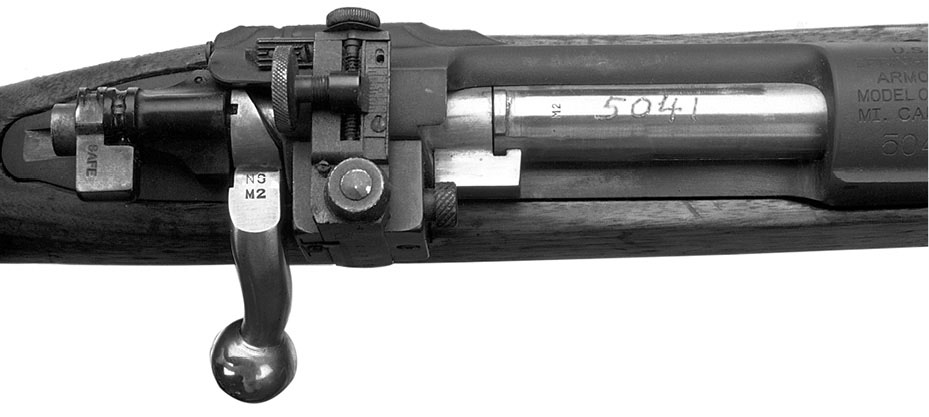

Model 1922 M2 Rifle • Paul Goodwin photo

Magazines for the U.S. M1922 (left) and 1922 M2 rifles (right) in .22LR. Price 1922, 300-150; 1922 M2, 175-80
U.S. Rifle M1 (Garand)
Springfield Armory was one of the manufacturers of this WWII service rifle. It is listed in the Garand section of this text.
Springfield M21 Sniper Rifle
This is the sniper rifle version of the M14 rifle with ART II scope. Early models were fitted with an M84 scope and Griffin & Howe mounts. This scope was followed by the ART I and finally the ART II scope in the early 1970s.

M21 with ART II scope and case • Courtesy Richard M. Kumor Sr.
Exc. |
V.G. |
Good |
Fair |
20000 |
18000 |
15000 |
— |
NOTE: Prices are for verifiable and registered samples.
The first smallbore, bolt-action repeating rifle that used smokeless powder that was adopted by the U.S. government as a service rifle. It was adopted as the Model 1892 and was similar to the rifle being used by Denmark as a service rifle. All of the Krag-Jorgensens were manufactured at the Springfield Armory. There are 11 basic variations of Krag Rifles, and all except one are chambered for the .30-40 Govt. cartridge. They are bolt actions that hold 5 rounds in the unique side-mounted hinged magazine. All of the Krags have walnut stocks and handguards that are oil-finished. They all have dark gray case-hardened receivers and blued barrels. See also Denmark, Rifles, Krag Jorgensen.
Bibliographical Note: For historical information, technical data, and photos, see Lt. Col. William Brophy’s, The Krag Rifle, Gun Room Press, 1985.
NOTE: One should be aware that there have been many alterations based on the Krag rifle by many gunsmiths through the years, and the one consistency is that all of these conversions lowered the value of the rifle and rendered it uncollectible. Proceed with caution. Prices listed are for original rifles as they left the factory.
Model 1892
Approximately 24,500 of these rifles produced, dated 1894, 1895, and 1896. They have 30” barrels and are serial numbered from 1-24562. Nearly all were converted to the latter Model 1896, and the original 1st Type is extremely scarce.
1st Type
Serial numbered from 1-1500 and is dated 1894 only. It features a wide upper barrel band and a brass tipped one-piece cleaning rod mounted under the barrel. There is no compartment in the butt, and the muzzle is not crowned and appears flat. The upper handguard does not extend over the receiver, and the buttplate is flat, without a compartment. Be wary of fakes. Unaltered specimens are extremely rare.
Exc. |
V.G. |
Good |
Fair |
|
— |
20000 |
12500 |
6500 |
3000 |
2nd Type
Similar to the 1st Type, with a front barrel band that is cut out in the center and does not appear solid. The cleaning rod is a one piece steel type. The serial number range is 1500-24562, and the dates 1894 or 1895 are stamped on the receiver and the stock. Again be wary of fakes. This is a rare rifle.
Exc. |
V.G. |
Good |
Fair |
— |
10000 |
7500 |
4000 |


Model 1922 M2 Rifle • Paul Goodwin photo
Model 1892 Altered to 1896 Model
Encompassed nearly the entire production run of the Model 1892 Krag rifle. They still bear the dates 1894, 1895, and 1896 on the receiver; but they do not have a one piece cleaning rod under the barrel, but instead a three-piece type inserted into the buttstock, and the hole in the stock has been plugged. The front barrel band was changed. The top handguard covers the receiver, and the buttplate is curved at the bottom. The muzzle is crowned.
Exc. |
V.G. |
Good |
Fair |
1800 |
950 |
750 |
450 |
Model 1895 Carbine (Variation)
Marked “1895” and “1896” on the receiver—without the word “Model.” They were produced before the Model 1896 was officially adopted, and they are serial numbered from 25000 to 35000. They are similar to the Model 1896 Carbine, with a smaller safety and no oiler bottle in the butt.


Model 1895 Carbine •Courtesy Rock Island Auction Company
Exc. |
V.G. |
Good |
Fair |
2500 |
1800 |
1250 |
650 |
Model 1896 Rifle
Similar to the altered Model 1892 and has a 30” barrel with the cleaning kit in the butt. The rear sight was improved, and the receiver is marked “U.S. Model 1896” and “Springfield Armory.” Lightening cuts were made in the barrel channel to reduce weight. A total of about 62,000 Model 96 rifles were produced in the same serial number range as the Model 1896 carbine of 37240 to 108471. The stock is dated 1896, 1897, and 1898. There were many of these altered to the later stock configurations—in the field or at the Springfield Armory. These changes would lower the value, and one should secure expert appraisal on this model.

Courtesy Richard M. Kumor Sr.
Exc. |
V.G. |
Good |
Fair |
2750 |
2000 |
1600 |
750 |
Model 1896 Carbine
Similar to the 1896 Rifle, with a 22” barrel and half-length stock held on by one barrel band. There were approximately less than 20,000 manufactured between 1896 and 1898, and the serial number range is 35000-90000. There were many rifles cut to carbine dimensions—be wary of these alterations!

Courtesy Jim Supica, Old Town Station

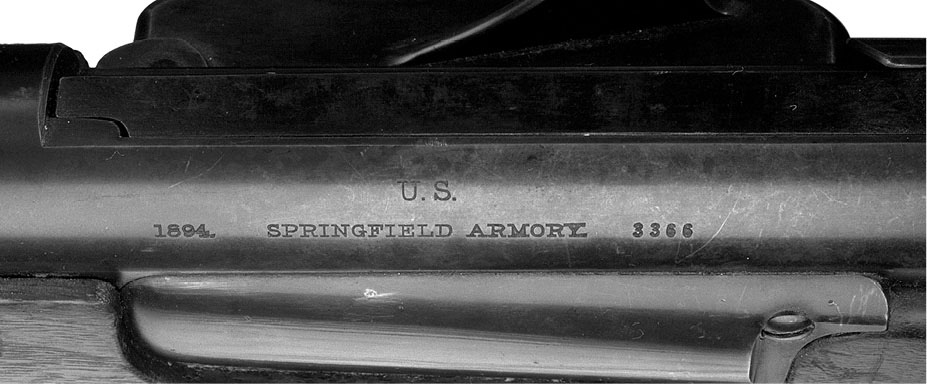
Krag Model 1892 2nd Type • Paul Goodwin photo


Model 1896 Cadet Rifle • Courtesy West Point Museum, Paul Goodwin photo
Exc. |
V.G. |
Good |
Fair |
3000 |
2250 |
1500 |
950 |
Model 1896 Cadet Rifle
A rare variation produced for use by the Military Academy at West Point. The dimensions are the same as the 1896 Rifle with a one-piece cleaning rod under the barrel and the 1896-type front band. There were 400 manufactured, and most were altered to standard configuration when they were phased out in 1898. Extremely rare in original and unaltered condition.
Exc. |
V.G. |
Good |
Fair |
— |
— |
37500 |
15000 |
Model 1892 Bayonet for Krag Jorgensen Rifles
Wood grips. Muzzle ring. 11.6” single edge blade. Marked with “SA” and production date on ricasso. Steel scabbard. The first knife bayonet issued by the U.S. It is a close copy of the Swiss M 1889 bayonet. Used on all the Krag models that take a bayonet. Price range 250 – 125.

Model 1892 Bayonet for Krag Jorgensen Rifles

Krag Rifle • Courtesy Paul S. Scarlata
Model 1898 Rifle
This model is similar to the Model 1896 in appearance except that the receiver is marked “U.S./Model 1898.” The bolt handle was modified, and the sights and handguards were improved. There were 330,000 manufactured between 1898 and 1903, and the serial number range is 110000-480000.
Exc. |
V.G. |
Good |
Fair |
1250 |
900 |
650 |
450 |
Model 1898 Carbine
Similar to the rifle, with a 22” barrel and a bar and ring on the left side of the receiver. There were approximately 5,000 manufactured in 1898 and 1899. The serial range is 118000-134000. Again, be aware that many of the rifles have been converted to carbine dimensions over the years. When in doubt, secure an independent appraisal.

Courtesy Little John’s Auction Service, Inc., Paul Goodwin photo
Exc. |
V.G. |
Good |
Fair |
2750 |
2000 |
1500 |
750 |
Model 1898 Carbine 26” Barrel
An attempt to satisfy both the infantry and the cavalry. There were 100 manufactured for trial, and the serial number range is between 387000-389000. Be wary of fakes.

Courtesy Little John’s Auction Service, Inc., Paul Goodwin photo
Exc. |
V.G. |
Good |
Fair |
— |
17500 |
7500 |
2500 |
Model 1898 Practice Rifle
The only Krag not chambered for the .30-40 cartridge. It is chambered for the .22 rimfire and was designed as a target-practice rifle. It has a 30” barrel and is identical in exterior appearance to the Model 1898 Rifle. The receiver is marked the same as the standard model—with “Cal .22” added. There were approximately 840 manufactured in 1906 and 1907. Serial numbers are above 475,000.
Exc. |
V.G. |
Good |
Fair |
— |
4500 |
2000 |
850 |
Model 1899 Carbine

Courtesy Milwaukee Public Museum, Milwaukee, Wisconsin
The last of the Krags. It is similar to the 1898, with the “Model 1899” stamped on the receiver and a 2” longer stock. There were approximately 36,000 manufactured between 1900 and 1903. Serial numbers observed are between 222609 and 362256. These numbers are part of the Model 1898 rifle series.
Exc. |
V.G. |
Good |
Fair |
1850 |
1400 |
900 |
750 |

Krag Carbine • Courtesy Paul S. Scarlata


Model 1899 Phillippine Constabulary Carbine • Courtesy Rock Island Auction Company
Model 1899 Philippine Constabulary Carbine
Approximately 8,000 modified to accept the knife bayonet at the Springfield Armory and the Rock Island Arsenal. The Springfield pieces are marked “J.F.C.” on the stock. This model has a 22” barrel with the full, but shortened, stock of the rifle held on with two barrel bands. One must exercise extreme care as many rifles were altered in a similar manner at later dates.
Exc. |
V.G. |
Good |
Fair |
2750 |
2000 |
1500 |
750 |
NOTE: Prices are for verifiable samples.
Arsenal Conversions
In the 1920s, the Department of Civilian Marksmanship had a number of Krag rifles converted for their use. These are Model 1898 rifles shortened to 24” and fitted with Model 1899 Carbine stocks. Some of these rifles were also fitted with rifle stocks shortened to carbine length. These conversions are beginning to be regarded as legitimate variations by some collectors of Krag rifles.
Exc. |
V.G. |
Good |
Fair |
500 |
450 |
400 |
250 |
NOTE: For historical information, technical details, and photos, see Blake Stevens’ and Edward Ezell’s, The Black Rifle: M16 Retrospective, Collector Grade Publications, 1994.
Berdan Single Shot Rifle (M.1870)
This is a scarce rifle on today’s market. There were approximately 30,200 manufactured, but nearly 30,000 of them were sent to Russia. This rifle was produced from 1866-1870. It is a trapdoor-type action chambered for .42 centerfire. The standard model has a 32.5” barrel; the carbine, 18.25”. The finish is blued, with a walnut stock. This rifle was designed and the patent held by Hiram Berdan, Commander of the Civil War “Sharpshooters” Regiment. This was actually Colt’s first cartridge arm. The 30,000 rifles and 25 half-stocked carbines that were sent to Russia were in Russian Cyrillic letters. The few examples made for American sales have Colt’s name and Hartford address on the barrel.
NOTE: For information on Russian-built Berdan rifles, see Russia, Rifles, Berdan.

Courtesy Milwaukee Public Museum, Milwaukee, Wisconsin
Rifle Russian Order
30,000 manufactured.
Exc. |
V.G. |
Good |
Fair |
3500 |
2500 |
1200 |
650 |
Carbine Russian Order
25 manufactured.
Exc. |
V.G. |
Good |
Fair |
— |
6000 |
3000 |
1250 |
Rifle U.S. Sales
100 manufactured.
Exc. |
V.G. |
Good |
Fair |
— |
5000 |
2250 |
1250 |
Carbine U.S. Sales
25 manufactured.
Exc. |
V.G. |
Good |
Fair |
— |
9500 |
4500 |
2000 |

M-6 Bayonet for M-14 Rifle
Colt-Franklin Military Rifle
This is a rifle that was not a successful venture for Colt. The patents were held by William B. Franklin, a vice-president of the company. This was a bolt-action rifle with a primitive, gravity-fed box magazine. It is chambered for the .45-70 government cartridge, has a 32.5” barrel, and is blued, with a walnut stock. The rifle has the Colt Hartford barrel address and is stamped with an eagle’s head and U.S. inspector’s marks. There were only 50 of these rifles produced, and it is believed that they were prototypes intended for government sales. This was not to be, and production ceased after approximately 50 were manufactured in 1887 and 1888.
Exc. |
V.G. |
Good |
Fair |
— |
8500 |
4500 |
2000 |
Lightning Slide Action, Medium Frame
This was the first slide action rifle Colt produced. It is chambered for .32-20, .38-40, and .44-40, and was intended to be a companion piece to the SAAs in the same calibers. The rifle has a 26” barrel with 15-shot tube magazine; the carbine, a 20” barrel with 12-shot magazine. The finish is blued, with case-colored hammer; the walnut stock is oil-finished; and the forend is usually checkered. The Colt name and Hartford address are stamped on the barrel along with the patent dates. There were approximately 89,777 manufactured between 1884 and 1902. The military variant is listed below.
Military Rifle or Carbine
Chambered for .44-40 caliber, fitted with short magazine tube, bayonet lug, and sling swivels. These guns are fitted with various barrel lengths.
Exc. |
V.G. |
Good |
Fair |
— |
4500 |
2000 |
1000 |
U.S. M14/M14E2
Based on the famous M1 Garand design this select fire rifle is chambered for the 7.62×51mm cartridge. It has a 21.8” barrel and a 20-round magazine. It weighs approximately 11.2 lbs. Rate of fire is about 750 rounds per minute. Marked “US RIFLE 7.62MM M14” on the rear top of the receiver. Production began in 1957 and ceased in 1963. Produced by Harrington & Richardson (537,512 total production) stamped “HRA,” Springfield (167,172 total production) stamped “SA,” Winchester (356,510 total production) stamped “66118” or “OM,” and TRW (319,163 total production) stamped “TRW.” The M14E2 version is a light machine gun variant with bipod, folding forward hand grip, and muzzle compensator.
NOTE: A sniper version of this rifle was designated the M21 and fitted with a Leatherwood telescope sight. See that listing.

Courtesy Richard M. Kumor Sr.
Pre-1968
Exc. |
V.G. |
Fair |
22000 |
18000 |
N/A |
Pre-1986 conversions (or U.S. manufacture/M1A Springfield Armory)
Exc. |
V.G. |
Fair |
12000 |
8500 |
N/A |

The M14 in Vietnam
M-6 Bayonet for M-14 Rifle
Checkered black plastic grip. Muzzle ring. 6.7” single edge blade. Issued in the M8A1 scabbard. Price range 125 – 50.
M16 ASSAULT RIFLE
The M16 rifle has a great many variations and configurations. Some of these variations are available to the collector and others are so rare as to be, for practical purposes, unavailable to the collector. Nevertheless, we think it important to include as many variations as may be encountered by the collector. Some of the more common ones will be priced while others, because of their rarity, will not show a value. Keep in mind that the M16 series of rifles is comprised of two main parts: the upper receiver and lower receiver. The upper receiver is not considered a firearm by the ATF and is not registered. Nor is the upper receiver marked or serial numbered to the lower receiver. Conversely, the lower receiver is serial numbered and marked with its model designation. It is therefore quite possible for upper receivers to be matched to lower receivers that are not in an original factory configuration. In order to be factory original, both upper and lower receivers must be configured at the factory prior to shipment. This is sometimes impossible to determine. It is therefore highly recommended that an expert be consulted prior to a sale to help determine originality.


M16A1 with Colt AR-15 markings with M203 grenade launcher • Paul Goodwin photo
MODEL NOTE: On early models, the “A” suffix usually means it has a forward assist and the “B” suffix usually means it has a burst mechanism. Model numbers began with the 600 series, then the 700 series, which are based on the M16A2. The 800 series models are grenade launchers (M203). The 900 series models have flat top upper receivers and removable carry handles. The following are model designations with Colt nomenclature:
XM16 became the M16
XM16E1 became the M16A1
M16A1E1 became the M16A2
M16A2E4 became the M16A4
GRENADE LAUNCHER NOTE: M203 launchers will retail for about $4,500 NIB, Launchers made by AAI will bring $15,000 because of their rarity.
NOTE: As a general rule of thumb, “U.S. Property” marked guns will bring a premium, in some cases a substantial one, depending on model and configuration. These premiums will be so stated where applicable. The M16 was also produced by GM’s Hydramatic division and Harrington & Richardson, Inc. Production began in late 1968. M16s from either manufacturer are rarely encountered. Rifles made by H&R will bring about 85 percent of a comparable Colt M16, while the Hydramatic rifles will bring almost double that of a Colt M16. This premium does not apply to rifles that have been re-welded.
Colt M16 NOTE: The Colt M16 comes in a variety of configurations (upper receivers), some of which are mentioned here. It is important to note that these configurations are based on the same lower receiver. In the case of civilian ownership, the lower receiver is the registered part of the firearm as far as the BATF is concerned. Therefore, it is possible, with a registered lower receiver, to interchange upper receiver components to a wide variety of different configurations from 9mm to .223 LMG uppers. Be aware that this interchangeability works best with Colt parts.
Bibliographical Note: For a full and complete description with photos, see Dan Shea’s Machine Gun Dealers Bible, 4th edition, Moose Lake Publishing. See Blake Stevens and Edward Ezell, The Black Rifle, M16 Retrospective, Collector Grade Publications, for an in-depth examination of the history and development of the M16. Since the 2nd edition of this book a new publication by Christopher R. Bartocci, Black Rifle II:The M16 into the 21st Century. Collector Grade Publications, 2004 is highly recommended.
600 Series
Colt/Armalite AR-15/M16 Model 601
This rifle was first produced in 1960 with many variants following. Chambered for the 5.56×45mm cartridge it has a 20.8” barrel with flash hider. Magazine capacity is 20 or 30 rounds. Weight is 7 lbs. Rate of fire is 800 rounds per minute. Used extensively in Vietnam and now throughout the world. Some were marked “COLT AR-15 PROPERTY OF US GOVT.M16 CAL 5.56MM” on left side of magazine housing, but early guns were not marked “US Property.” There is a wide variation in prices and models. Prices listed below are for the standard Colt/Armalite rifle.
NOTE: For Armalite only marked rifles no price given because of rarity. For Colt only marked rifles deduct $2,000.

AR-15 markings • Courtesy James Alley
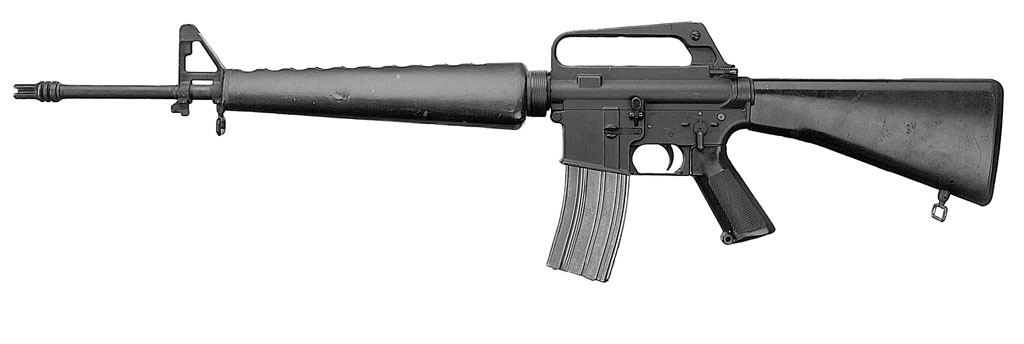
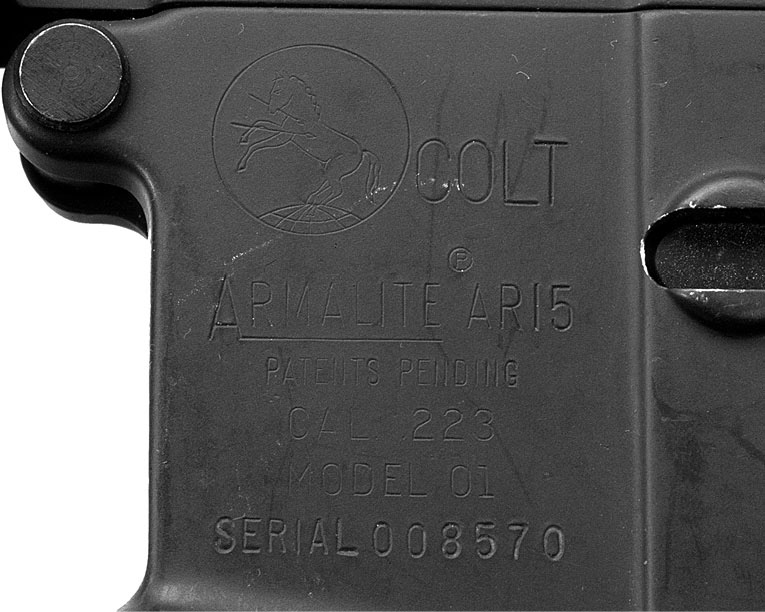
Early AR-15 Model 01 • Paul Goodwin photo
Pre-1968
Exc. |
V.G. |
Fair |
20000 |
18500 |
15000 |
Colt Model 602
This U.S. (“US Property”) model was fitted with a 20” barrel. It has no forward assist. Select fire in full or semi-auto.
Colt Model 603 (M16A1)
This U.S. (“US Property”) model has a 20” barrel with forward assist. Barrel has a 1 in 12 twist rate. Select fire in full or semi-auto.
Pre-1968
Exc. |
V.G. |
Fair |
18500 |
17000 |
15000 |
Colt Model 604 (M16)
This U.S. (“US Property”) Air Force model has a 20” barrel with a 1 in 12 twist. No forward assist. Select fire in full and semi-auto.
Pre-1968
Exc. |
V.G. |
Fair |
18000 |
17000 |
15000 |
Colt Model 605A CAR-15 Carbine
This U.S. (“US Property”) version is the short barrel (10”) version of the rifle with a forward assist. A select fire in full and semi-auto.

CAR-15 • Courtesy James Alley
Pre-1968
Exc. |
V.G. |
Fair |
22000 |
20000 |
18500 |
Pre-1986 OEM/Colt
Exc. |
V.G. |
Fair |
N/A |
N/A |
N/A |
Colt Model 605B
This U.S. (“US Property”) version is the same as above but with semi-auto, full auto, and burst (3-round) select fire. No forward assist.
Pre-1968
Exc. |
V.G. |
Fair |
22000 |
20000 |
18500 |
Colt Model 606
This is the export version of the Model 616.
Pre-1968
Exc. |
V.G. |
Fair |
18000 |
17000 |
16500 |
Colt Model 606B
As above, but with burst version.
Pre-1968
Exc. |
V.G. |
Fair |
18000 |
17000 |
16500 |
Colt Model 607
This U.S. (“US Property”) version is an SMG with sliding buttstock and 10” barrel. Designed for use by tank, helicopter, and APC crews. Length with stock closed is 26”, with stock extended about 28.7”. Weight is about 5.3 lbs.
Pre-1968
Exc. |
V.G. |
Fair |
20000 |
18000 |
17500 |

Colt Survival Rifle Model 608 • Courtesy James Alley
Colt Model 608 Survival Rifle
This rifle was built in prototype only and its design was for use by aviation personnel. Fitted with a 10” barrel, cone shaped flash suppressor, short fixed buttstock, round handguard, no forward assist, no bayonet lug, and short pistol grip. Overall length is 29”. Weight was slightly more than 4.7 lbs. Designed to be broken down to fit the standard USAF seat pack. Fewer than 10 manufactured.
Pre-1968
Exc. |
V.G. |
Fair |
30000 |
29000 |
28500 |
Pre-1986 OEM/Colt
Exc. |
V.G. |
Fair |
N/A |
N/A |
N/A |
Colt Model 609 (XM177E1)
This is a U.S. Army version of the Commando with an 11.5” barrel with a 1 in 12 twist rate. This model has a forward assist. Select fire in full auto or semi-auto.
Pre-1968
Exc. |
V.G. |
Fair |
25000 |
22500 |
21500 |
Colt Model 610 (GAU-5/A)
This is the U.S. Air Force version of the XM177 Commando with 10” barrel with 1 in 12 twist and no forward assist. Select fire in full auto or semi-auto.
Pre-1968
Exc. |
V.G. |
Fair |
25000 |
22500 |
21500 |
Colt Model 613
This is export version of the 603.
Pre-1968
Exc. |
V.G. |
Fair |
15000 |
12500 |
10500 |
Colt Model 614
This is the export version of the Model 604.
Pre-1968
Exc. |
V.G. |
Fair |
15000 |
12500 |
10500 |
Colt Model 616
This U.S. (“US Property”) version is fitted with a 20” heavy barrel with 1 in 12 twist rate. No forward assist. Select fire in full auto or semi-auto.
Pre-1968
Exc. |
V.G. |
Fair |
20000 |
18500 |
17500 |
Colt Model 619
This is the export version of the 609.
Pre-1968
Exc. |
V.G. |
Fair |
20000 |
18500 |
17500 |

Markings for U.S. property for Commando model • Courtesy James Alley
Colt Model 621
This U.S. (“US Property”) version is fitted with a 20” heavy barrel with 1 in 12 twist. It is fitted with a forward assist. Select fire in full auto or semi-auto.
Pre-1968
Exc. |
V.G. |
Fair |
20000 |
18500 |
17500 |

Colt Model 629 (XM177E2) • Courtesy James Alley
Colt Model 629 (XM177E2)
This is the U.S. Army version of the Commando with 11.5” barrel with 1 in 12 twist. Sliding butt stock. Fitted with a forward assist. Select fire in full auto or semi-auto. Equipped with a 4.5” flash suppressor. Weight is about 6.2 lbs without magazine.
Pre-1968
Exc. |
V.G. |
Fair |
25000 |
22500 |
21000 |
Colt Model 630 (GAU-5/A/B)
This is the U.S. Air Force version of the XM177E1 with 11.5” barrel with 1 in 12 twist. No forward assist. Select fire in full auto or semi-auto.
Pre-1968
Exc. |
V.G. |
Fair |
25000 |
22500 |
21000 |
Colt Model 639
This is the export version of the Model 629.
Pre-1968
Exc. |
V.G. |
Fair |
20000 |
18500 |
17500 |
Colt Model 645 (M16A2)
This model is an improved variation of the M16A1 Standard rifle with a 1 in 7 barrel twist and a heavier 20” barrel. A case deflector is mounted on the right side. Sights are an improved version of the standard M16 type. Forward assist. Improved flash suppressor, buttstock, and pistol grip. First produced in 1982. See list of M16A2 modifications on prior page.
Pre-1968
Exc. |
V.G. |
Fair |
N/A |
N/A |
N/A |
Pre-1986 OEM/Colt
Exc. |
V.G. |
Fair |
16000 |
15000 |
14000 |
Colt Model 646 (M16A3)
This is the U.S. (“US Property”) version of the M16A3 except that there is no 3-round burst but full auto and semi-auto.
Colt Model 649 (GAU-5/A/A)
This is the U.S. Air Force version of the XM177E2 with 11.5” barrel with 1 in 12 twist rate and no forward assist. Select fire with full auto and semi-auto. Equipped with a 4.5” flash suppressor.
Pre-1968
Exc. |
V.G. |
Fair |
25000 |
22500 |
21500 |
Colt Model 651
This is the export version of the rifle with 14.5” barrel.
Pre-1968
Exc. |
V.G. |
Fair |
20000 |
18500 |
17500 |
Colt Model 652
This is the export version of the rifle with 14.5” barrel and no forward assist.
Pre-1968
Exc. |
V.G. |
Fair |
15000 |
14000 |
13000 |
Colt Model 653
This is the export version of the rifle with 14.5” barrel and sliding buttstock.
Pre-1968
Exc. |
V.G. |
Fair |
15000 |
14000 |
13000 |
Colt Model 655 (Sniper)
This was a U.S. (“US Property”) prototype version with a 20” barrel with a 1 in 9 twist rate. It has a forward assist. The upper receiver has a high profile scope mount and was to have been fitted with a Leatherwood Realist scope and Sionics suppressor. Select fire with full auto or semi-auto.
Colt Model 656 (Sniper)
Same as above but with a special low profile upper receiver with no carry handle and low profile scope mount.
700 Series–Export Versions of the M16A2
NOTE: A2 Military serial number are in the 6000000 range and A2 Civilian models are in the 8000000.
Colt Model 701 Export Rifle
This is the M16A2 with 20” barrel and all the A2 features. Weight is about 7.5 lbs.
Colt Model 703 Test Model
This is a test model with a gas piston designated the M703/16A2. Test model used an AK type bolt and carrier. Test model is not priced.
Colt Model 703 Export Rifle
(There are two different types of 703s. Colt used the same model designation twice. See above.) Select fire with semi, 3-round burst, and full auto. The Export Model is an M16A2 style rifle.
Pre-1968
Exc. |
V.G. |
Fair |
N/A |
N/A |
N/A |
Pre-1986 OEM/Colt
Exc. |
V.G. |
Fair |
18500 |
17500 |
16500 |
Colt Model 707 Export rifle
This is a M16A2 with 20” A1 style barrel with 1-in-7 twist rate. Select fire with semi, 3-round burst. Weight is about 7.5 lbs.
Pre-1968
Exc. |
V.G. |
Fair |
N/A |
N/A |
N/A |
Pre-1986 conversions
Exc. |
V.G. |
Fair |
18500 |
17500 |
16500 |
NOTE: For OEM A1 add 40 percent.

Model 711 • Courtesy James Alley
Colt Model 711 Export Rifle
This model is the same as the M16A2 but fitted with M16A1 sights and standard weight M16A1 barrel.
Pre-1968
Exc. |
V.G. |
Fair |
N/A |
N/A |
N/A |
Pre-1986 conversions
Exc. |
V.G. |
Fair |
16500 |
15500 |
15000 |
NOTE: For OEM A1 add 40 percent.
Colt Model 713 Export Rifle
This model is fitted with an M16A1 upper receiver with case deflector 20” A1 barrel with 1 in 7 twist. Buttstock is A2 type. The compensator is A2 type with A2 lower receiver with select fire in semi and 3-round burst. Weight is about 7 lbs.
Pre-1968
Exc. |
V.G. |
Fair |
N/A |
N/A |
N/A |
Pre-1986 conversions
Exc. |
V.G. |
Fair |
16500 |
15500 |
15000 |
NOTE: For OEM A1 add 40 percent.
Colt Model 723 Export Carbine
This model is an M16A2 carbine with lightweight 14.5” barrel, M16A1 sights, and telescoping stock. Select fire in semi-auto and full auto.
Pre-1968
Exc. |
V.G. |
Fair |
N/A |
N/A |
N/A |
Pre-1986 conversions
Exc. |
V.G. |
Fair |
18500 |
17500 |
16500 |
NOTE: For OEM A1 add 40 percent.
Colt Model 725 Export Carbine
Same as the Model 723 but with semi-auto and three-round burst select fire.
Pre-1968
Exc. |
V.G. |
Fair |
N/A |
N/A |
N/A |
Pre-1986 conversions
Exc. |
V.G. |
Fair |
17500 |
16500 |
15500 |
NOTE: For OEM A1 add 40 percent.

M16A2 Model 723 and Model 733 • Courtesy James Alley
Colt Model 727 Carbine
This is the M16A2 version of the M4 Carbine. Fitted with a 14.5” barrel capable of accepting the M203 grenade launcher. Rifling twist is 1 in 7. Sliding buttstock. Rate of fire is 700 to 950 rounds per minute. Select fire in semi-auto and full auto. Weight is about 5.65 lbs without magazine.
Pre-1968
Exc. |
V.G. |
Fair |
N/A |
N/A |
N/A |
Pre-1986 conversions
Exc. |
V.G. |
Fair |
18500 |
17500 |
16500 |
NOTE: For OEM A1 add 40 percent.
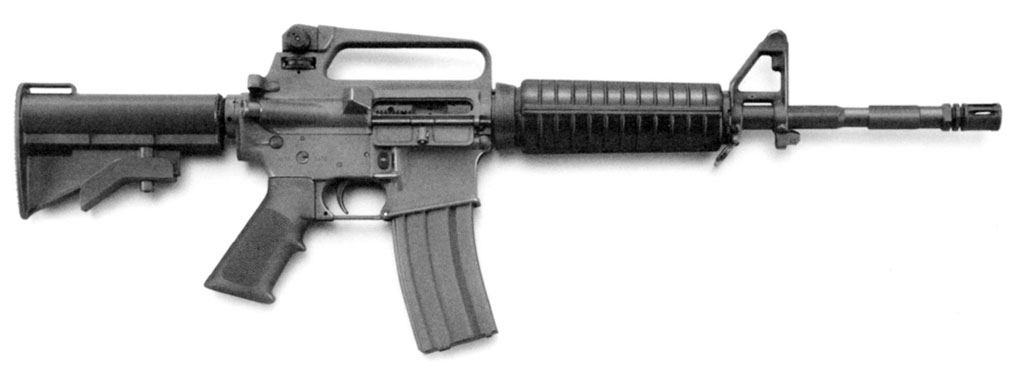
M16A2 Model 727 • Courtesy James Alley
Colt Model 733 Export Commando
This model is the M16A2 Commando with an 11.5” barrel, M16A1 sight, telescoping butt.
Pre-1968
Exc. |
V.G. |
Fair |
N/A |
N/A |
N/A |
Pre-1986 OEM/Colt
Exc. |
V.G. |
Fair |
20000 |
18500 |
17500 |
Colt Model 741 Export Heavy Barrel
This is an M16A2 with 20” heavy barrel that is magazine fed. Designed as a SAW (Squad Automatic Weapon). Weight is about 10 lbs.
Pre-1968
Exc. |
V.G. |
Fair |
N/A |
N/A |
N/A |
Pre-1986 conversions
Exc. |
V.G. |
Fair |
18500 |
17500 |
16500 |
NOTE: For OEM A1 add 40 percent.
Colt Model 750 LMG (See U.S., Machine Guns)
Colt Model 720 M4 (Original Version)
This is a short barrel version of the M16 with collapsible stock. Chambered for 5.56×45mm cartridge. It is fitted with a 14.5” barrel and has a magazine capacity of 20 or 30 rounds. Its rate of fire is 800 rounds per minute. Weight is about 5.6 lbs. Marked “COLT FIREARMS DIVISION COLT INDUSTRIES HARTFORD CONN USA” on the left side of the receiver, with “COLT M4 CAL 5.56MM” on the left side of the magazine housing. In use with American military forces as well as several South American countries.
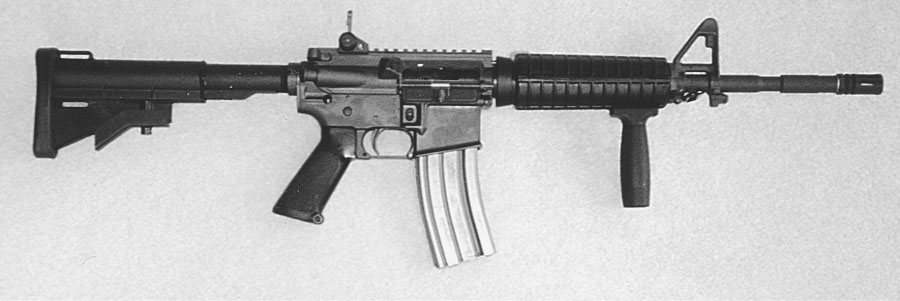
Courtesy private NFA collection
Pre-1968
Exc. |
V.G. |
Fair |
N/A |
N/A |
N/A |
Pre-1986 conversions or OEM/Colt (Rare)
Exc. |
V.G. |
Fair |
25000 |
22500 |
21500 |
900 Series
Colt Model 920—M4
This model is the current U.S. (“US Property”) version of the flat top carbine with 14.5” barrel with a 1 in 7 twist rate, forward assist, sliding buttstock, and A2 improvements. Select fire with 3-round burst and semi-auto.
Colt Model 921—M4A1
This U.S. (“US Property”) model is the same as the Model 920, except it is full auto with no burst feature.

Copyright by Colt Defense LLC. used with permission, all rights reserved, Courtesy Blake Stevens, Black Rifle II, Collector Grade Publications

Close-up of Colt M4A1 carbine • Copyright by Colt Defense LLC. used with permission, all rights reserved, Courtesy Blake Stevens, Black Rifle II, Collector Grade Publications
Colt Model 945—M16A4
This U.S. (“US Property”) version is the flat top version of the M16A2.
Specialty Series
Colt CAR-15 Model M1 Heavy Assault Rifle
This was a prototype with a heavy AR-15 20” barrel. Fires from a closed bolt. Uses standard M16 magazines. Weight without magazine is about 7.6 lbs. Semi or full auto fire. Rate of fire is approximately 800 to 850 rounds per minute.
Colt CAR-15 Model M2 Belt-fed Heavy Assault Rifle
Similar to the M1 version with the addition of a removable belt feeding mechanism designed by Rob Roy. Weight is about 8.3 lbs. Also feeds from standard M16 magazines. Less than 20 M2s were built.
Pre-1968
Exc. |
V.G. |
Fair |
N/A |
N/A |
N/A |
Pre-1986 OEM/Colt
Exc. |
V.G. |
Fair |
35000+ |
— |
— |
Colt M231 Firing Port Weapon
This gun was never assigned a Colt model number but was fitted with a 15.6” barrel and a 1 in 12 twist rate. It fired from an open bolt in full auto only. It had no sights or buttstock. All original Colt firing port guns have an “F” prefix as part of the serial number and are marked “US PROPERTY.”

Colt Firing Port weapon • Courtesy James Alley

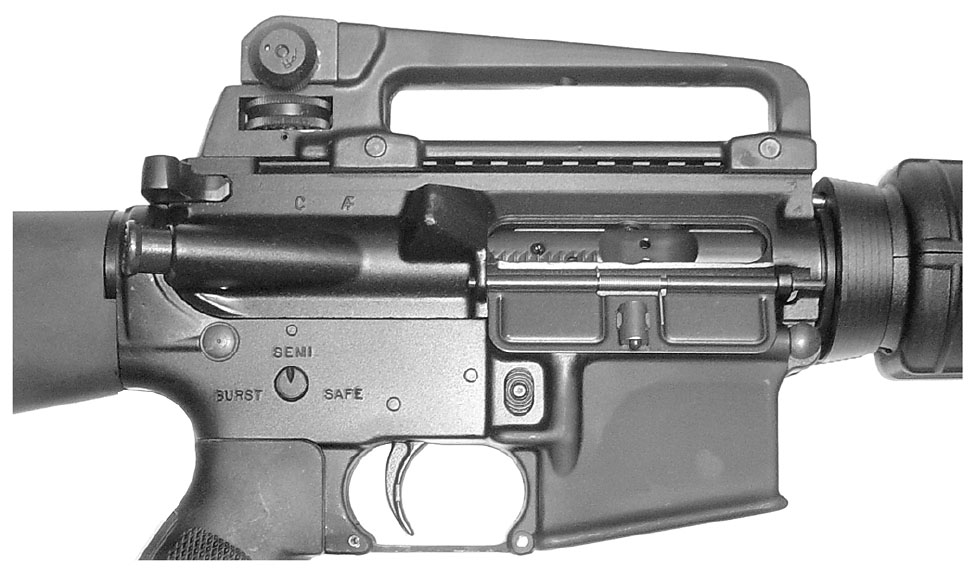
Close-up of left side of M16A4 receiver • Copyright by Colt Defense LLC. used with permission, all rights reserved, Courtesy Blake Stevens, Black Rifle II, Collector Grade Publications

Model M1 Heavy Assault Rifle • Courtesy James Alley
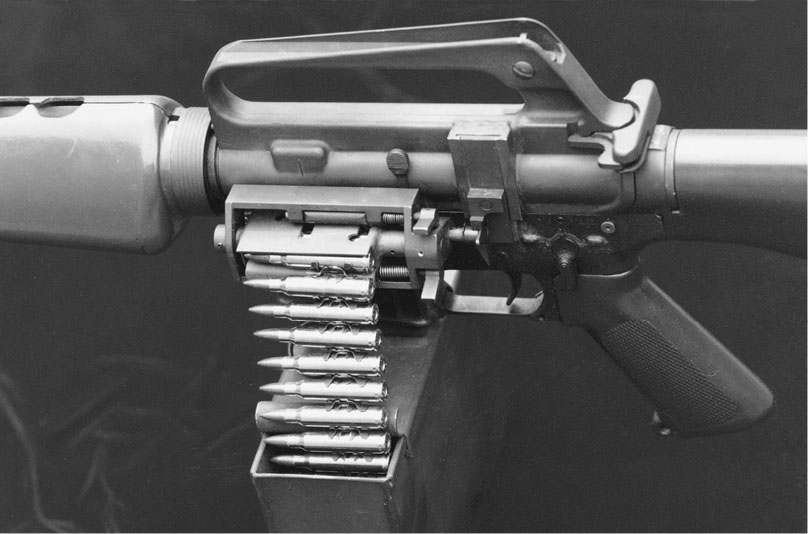

M2 Belt fed with close-up • Courtesy James Alley
Pre-1968
Exc. |
V.G. |
Fair |
N/A |
N/A |
N/A |
Pre-1968 OEM/Colt
Exc. |
V.G. |
Fair |
22000 |
20000 |
18500 |
Colt ACR Advanced Combat rifle
This model was built in prototype only and was designed to fire special duplex cartridges. It was fitted with a 20” barrel, flattop receiver with special rib designed by Aberdeen Human Engineering Labs. It has a sliding buttstock with a hydraulic buffer. Select fire in full auto or semi-auto.
Pre-1968
Exc. |
V.G. |
Fair |
N/A |
N/A |
N/A |
Pre-1986 OEM/Colt
Exc. |
V.G. |
Fair |
|
Too |
Rare |
To |
Price |
Colt CMG-1
One prototype was built of this model. It was a belt-fed light machine gun designed by Rob Roy and fitted with a 20” barrel with a 1-in-12 twist. Rate of fire of 650 rounds per minute. Weight is about 12.5 lbs. Fires from an open bolt. Designed to be used as a tripod mount, bipod mount, vehicle mount, or solenoid fixed machine gun.

Colt CMG1 • Courtesy James Alley
Colt CMG-2
This was an improved version of the CMG-1 designed by George Curtis and Henry Tatro. Approximately 6 were produced, 5 in 5.56 NATO and 1-in-7.62 NATO. It was fitted with a 20” quick change barrel with a 1 in 8.87” twist for the 68 grain GX-6235 bullet. Hydraulic buffer in buttstock. Bipod. Weight was about 15 lbs. Cycle rate is about 650 rounds per minute. It is fed by a 150-round belt fed drum magazine. These prototypes were built by Colt between 1967 and 1969.
Pre-1968
Exc. |
V.G. |
Fair |
N/A |
N/A |
N/A |
Pre-1986 OEM/Colt
Exc. |
V.G. |
Fair |
40000+ |
— |
— |
NOTE: There is little in the way of sales history, though there have been guns offered for sale in the $40,000 to $75,000 range on rare occasions.
M16 Rimfire Conversion Kits
There are several different conversion kits featuring different designs both adapted by the U.S. military. Both of these kits use a 10-round magazine but are not interchangeable with each other. The first is the Rodman design, known as the Air Force Model, built by OK Industries, New Britain, CT and the second is the M261 built by the Maremont Corp., Saco, ME. TM 9-6920-363-12 was issued with the M261 conversion kit. The Atchisson Mark I and Mark II kits and the Atchisson Mark III made by Jonathan Ciener, Inc., are also used by military forces in the U.S. as well as by foreign governments. The Ciener kit was introduced about 1988 and is designed to be used in both the M16 and AR15 rifles, both semi-automatic fire and full auto fire. Rate of fire is between 700 and 800 rounds per minute in the M16.

Colt CMG2 • Courtesy James Alley
NOTE: Colt built a conversion kit produced for commercial sale but this kit was not adopted by the military.
Ciener Kit Mark III
Exc. |
V.G. |
Good |
Fair |
300 |
200 |
— |
— |
M-7 Bayonet for M-16 Rifle
Checkered black plastic grip. Large muzzle ring to fit over flash hider. 6.5” single edge blade. Made by several contractors. Issued in the M8A1 scabbard. Price range 50 – 25.
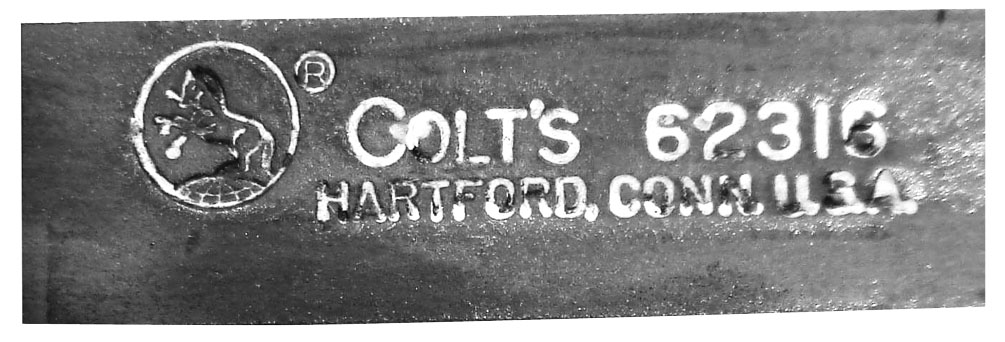
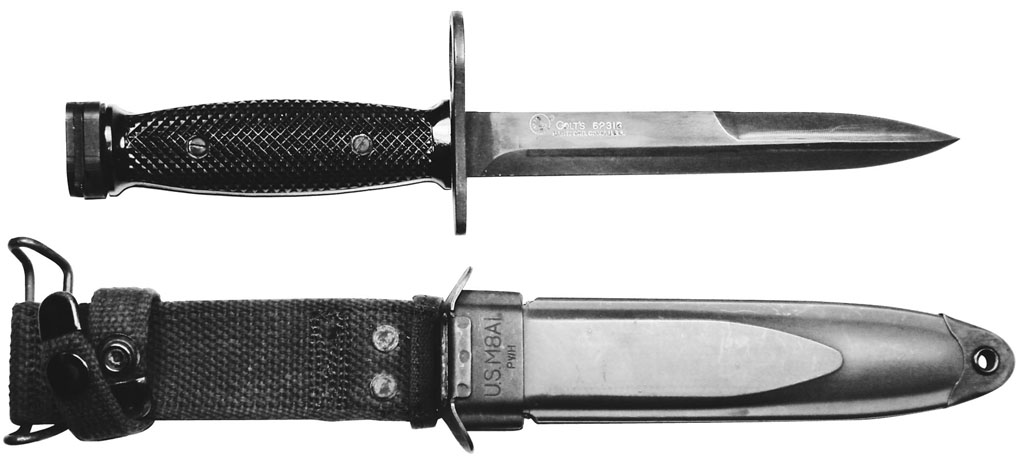
M-7 Bayonet marked “Colt”
M-7 Bayonet Marked “Colt”
As above, but made in Germany by Carl Eickhorn for Colt. Made for commercial sales of the M-16 series. Not military issue. Price range 250 –150.

M-9 Bayonet for M-16A2
M-9 Bayonet for M-16A2
Metal handle. Muzzle ring. 7.2” single-edge blade. Plastic scabbard has sharpening stone on back. There is a wire cutting feature like that on the Russian AKM series. Price range 225 – 125.
AR-15 Series
AR-15 Sporter (Model #6000)
A semi-automatic rifle firing from a closed bolt was introduced into the Colt product line in 1964. Similar in appearance and function to the military version, the M-16. Chambered for the .223 cartridge. It is fitted with a standard 20” barrel with no forward assist, no case deflector, but with a bayonet lug. Weighs about 7.5 lbs. Dropped from production in 1985.
Exc. |
V.G. |
Good |
Fair |
1500 |
1100 |
900 |
600 |

Copyright by Colt Defense LLC. used with permission, all rights reserved, Courtesy Blake Stevens, Black Rifle II, Collector Grade Publications
AR-15 Sporter w/Collapsible Stock (Model #6001)
Same as above but fitted with a 16” barrel and sliding stock. Weighs approximately 5.8 lbs. Introduced in 1978 and discontinued in 1985.
Exc. |
V.G. |
Good |
Fair |
1800 |
1200 |
800 |
600 |
AR-15 Carbine (Model #6420)
Introduced in 1985 this model has a 16” standard weight barrel. All other features are the same as the previous discontinued AR-15 models. This version was dropped from the Colt product line in 1987.
Exc. |
V.G. |
Good |
Fair |
1500 |
1250 |
1000 |
N/A |
AR-15 9mm Carbine (Model #6450)

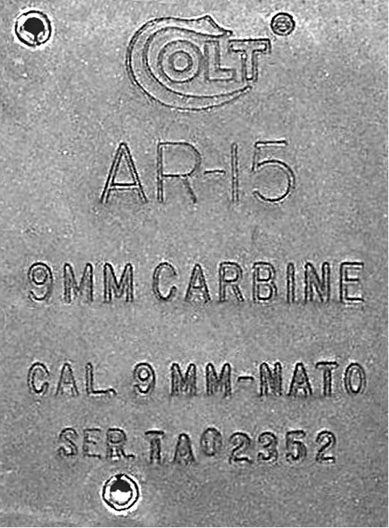
Copyright by Colt Defense LLC. used with permission, all rights reserved, Courtesy Blake Stevens, Black Rifle II, Collector Grade Publications
Same as above but chambered for 9mm cartridge. Weighs 6.3 lbs.
Exc. |
V.G. |
Good |
Fair |
1500 |
1200 |
1000 |
N/A |
AR-15A2 (Model #6500)
Introduced in 1984, this was an updated version with a heavier barrel and forward assist. The AR sight was still utilized. Weighs approximately 7.8 lbs.
Exc. |
V.G. |
Good |
Fair |
|
1500 |
1250 |
1100 |
900 |
N/A |
AR-15A2 Govt. Model Carbine (Model #6520)
Added to the Colt line in 1988, this 16” standard barrel carbine featured for the first time a case deflector, forward assist, and the improved A2 rear sight. This model is fitted with a 4-position telescoping buttstock. Weighs about 5.8 lbs.
Exc. |
V.G. |
Good |
Fair |
1500 |
1500 |
1100 |
N/A |
AR-15A2 Gov’t. Model (Model #6550)
This model was introduced in 1988; it is the rifle equivalent to the Carbine. It features a 20” A2 barrel, forward assist, case deflector, but still retains the bayonet lug. Weighs about 7.5 lbs. Discontinued in 1990.

Exc. |
V.G. |
Good |
Fair |
1500 |
1250 |
1000 |
800 |
AR-15A2 H-Bar (Model #6600)
Introduced in 1986, this version features a special 20” heavy barrel. All other features are the same as the A2 series of AR15s. Discontinued in 1991. Weighs about 8 lbs.

Exc. |
V.G. |
Good |
Fair |
1500 |
1250 |
1000 |
N/A |
AR-15A2 Delta H-Bar (Model #6600DH)
Same as above but fitted with a 3×9 Tasco scope and detachable cheekpiece. Dropped from the Colt line in 1990. Weighs about 10 lbs. Equipped with a metal carrying case.
Exc. |
V.G. |
Good |
Fair |
2000 |
1500 |
1250 |
N/A |
Sporter Lightweight Rifle
This lightweight model has a 16” barrel and is finished in a matte black. It is available in either a .223 Rem. caliber (Model #6530) that weighs 6.7 lbs., a Model #6430 w/A1 sights, 9mm caliber weighing 7.1 lbs., or a Model #6830 7.65×39mm that weighs 7.3 lbs. The .223 is furnished with two five-round box magazines as is the 9mm and 7.65×39mm. A cleaning kit and sling are also supplied with each new rifle. The buttstock and pistol grip are made of durable nylon and the handguard is reinforced fiberglass and aluminum lined. The rear sight is adjustable for windage and elevation. These newer models are referred to simply as Sporters and are not fitted with a bayonet lug and the receiver block has different size pins.


Exc. |
V.G. |
Good |
Fair |
1200 |
1000 |
850 |
N/A |
Sporter Target Model Rifle (Model #6551)
This 1991 model is a full size version of the Lightweight Rifle. The Target Rifle weighs 7.5 lbs. and has a 20” barrel. Offered in .223 Rem. caliber only with target sights adjustable to 800 meters. New rifles are furnished with two 5-round box magazines, sling, and cleaning kit. Same as the Model 6550 except for a rib around the magazine release.
Exc. |
V.G. |
Good |
Fair |
1250 |
950 |
850 |
N/A |


Copyright by Colt Defense LLC. used with permission, all rights reserved, Courtesy Blake Stevens, Black Rifle II, Collector Grade Publications
Sporter Match H-Bar (Model #6601)
This 1991 variation of the AR-15 is similar to the Target Model but has a 20” heavy barrel chambered for the .223 caliber. This model weighs 8 lbs. and has A2 sights adjustable out to 800 meters. Supplied with two 5-round box magazines, sling, and cleaning kit.
Exc. |
V.G. |
Good |
Fair |
1400 |
950 |
850 |
N/A |
Sporter Match Delta H-Bar (Model #6601 DH)
Same as above but supplied with a 3×9 Tasco scope. Has a black detachable cheekpiece and metal carrying case. Weighs about 10 lbs. Discontinued in 1992. Deduct 150 if there is no scope or hard case.
Exc. |
V.G. |
Good |
Fair |
1850 |
1500 |
1200 |
N/A |
Match Target H-BAR Compensated (Model MT6601C)
Same as the regular Sporter H-BAR with the addition of a compensator.

Exc. |
V.G. |
Good |
Fair |
1200 |
850 |
700 |
N/A |
Sporter Competition H-Bar (Model #6700)

Introduced in 1992, the Competition H-Bar is available in .223 caliber with a 20” heavy barrel counterbored for accuracy. The carry handle is detachable with A2 sights. With the carry handle removed the upper receiver is dovetailed and grooved for Weaver-style scope rings. This model weighs approximately 8.5 lbs. New rifles are furnished with two 5-round box magazines, sling, and cleaning kit.